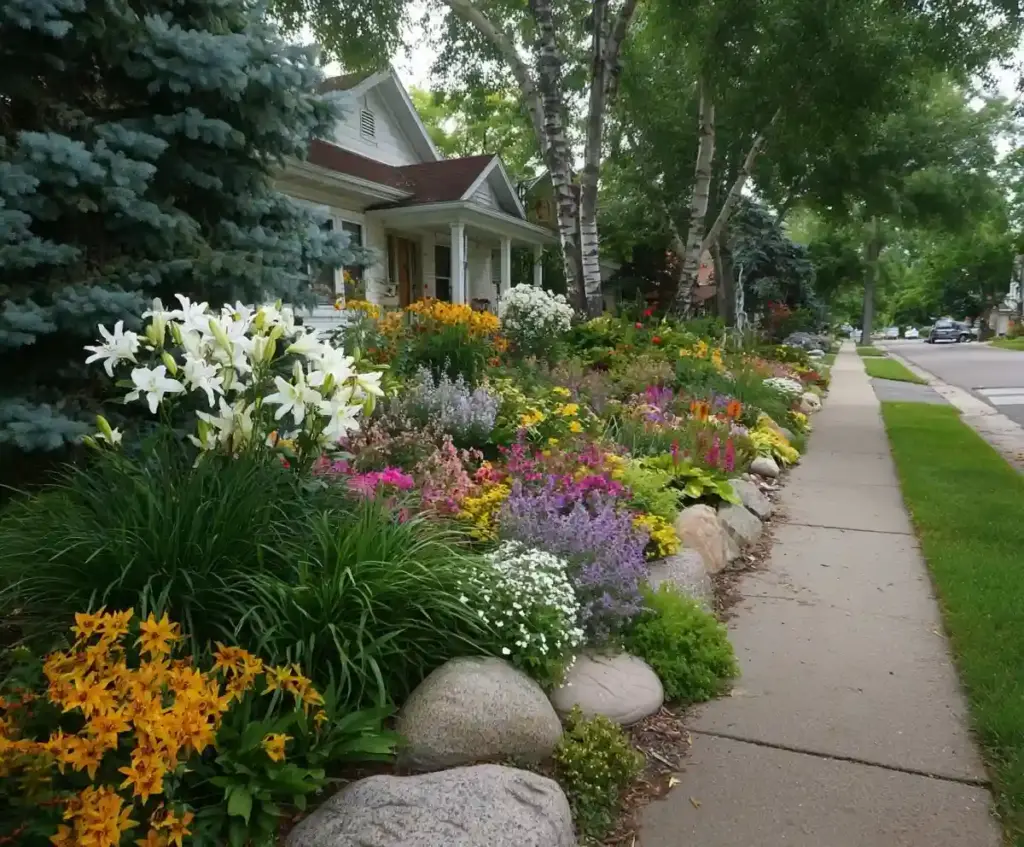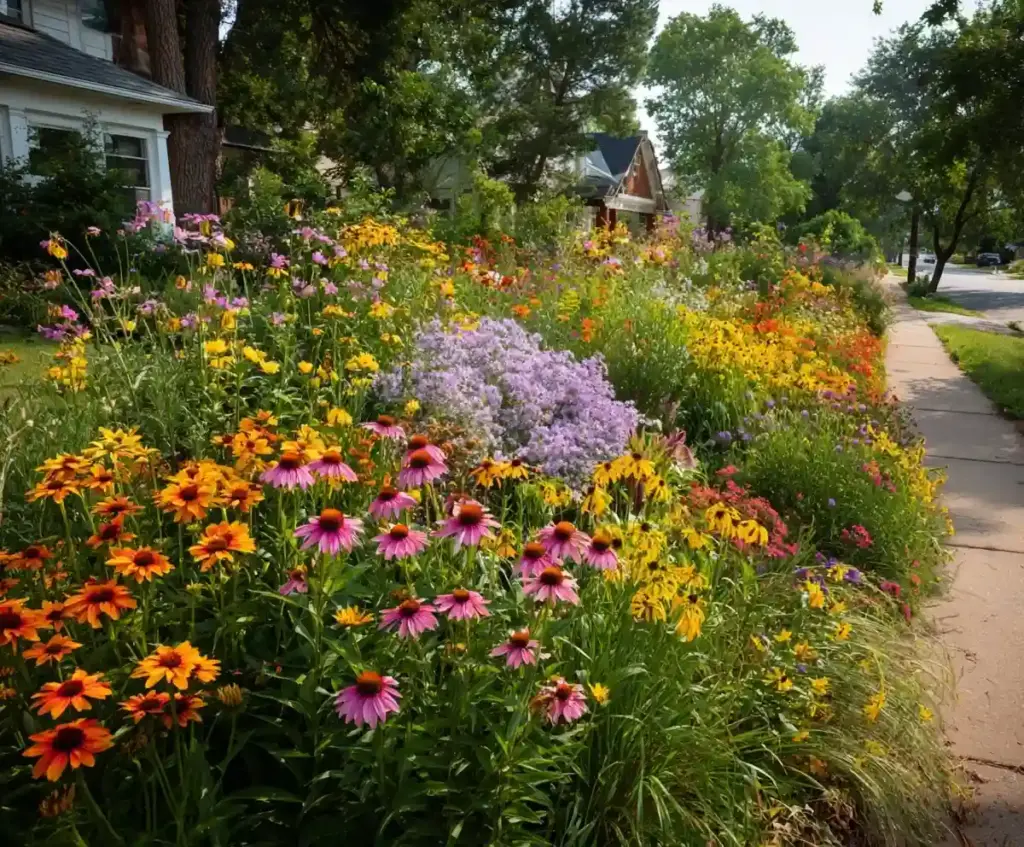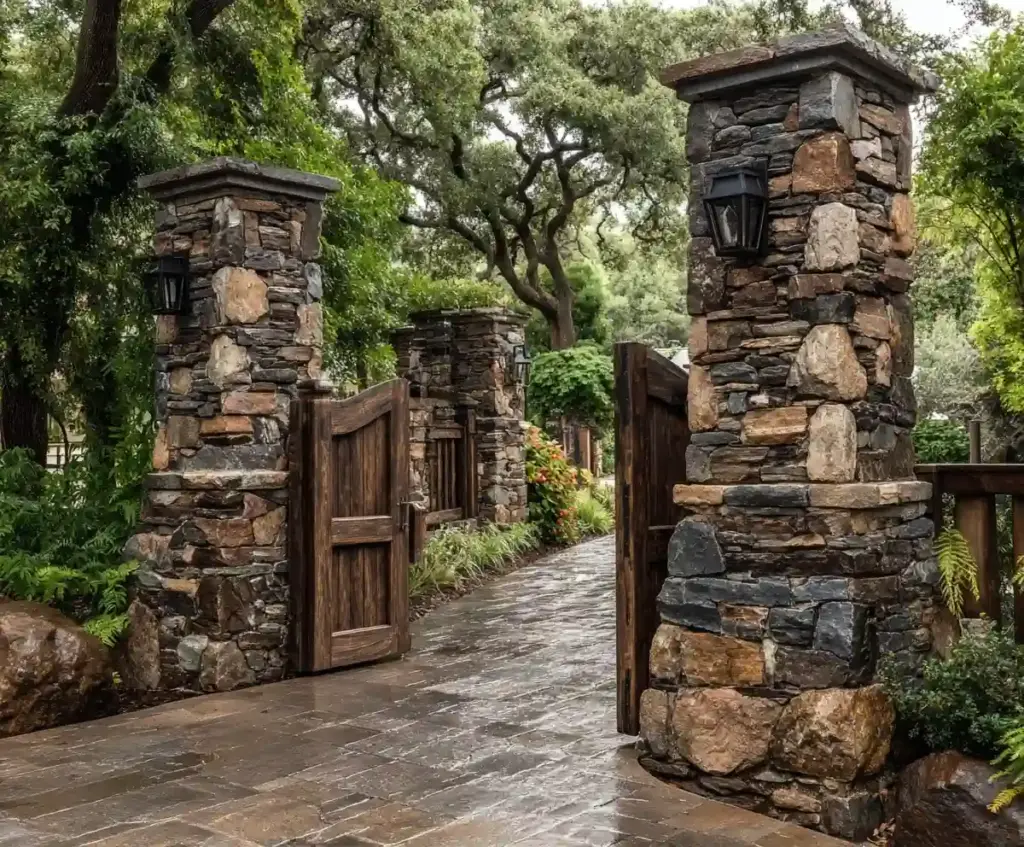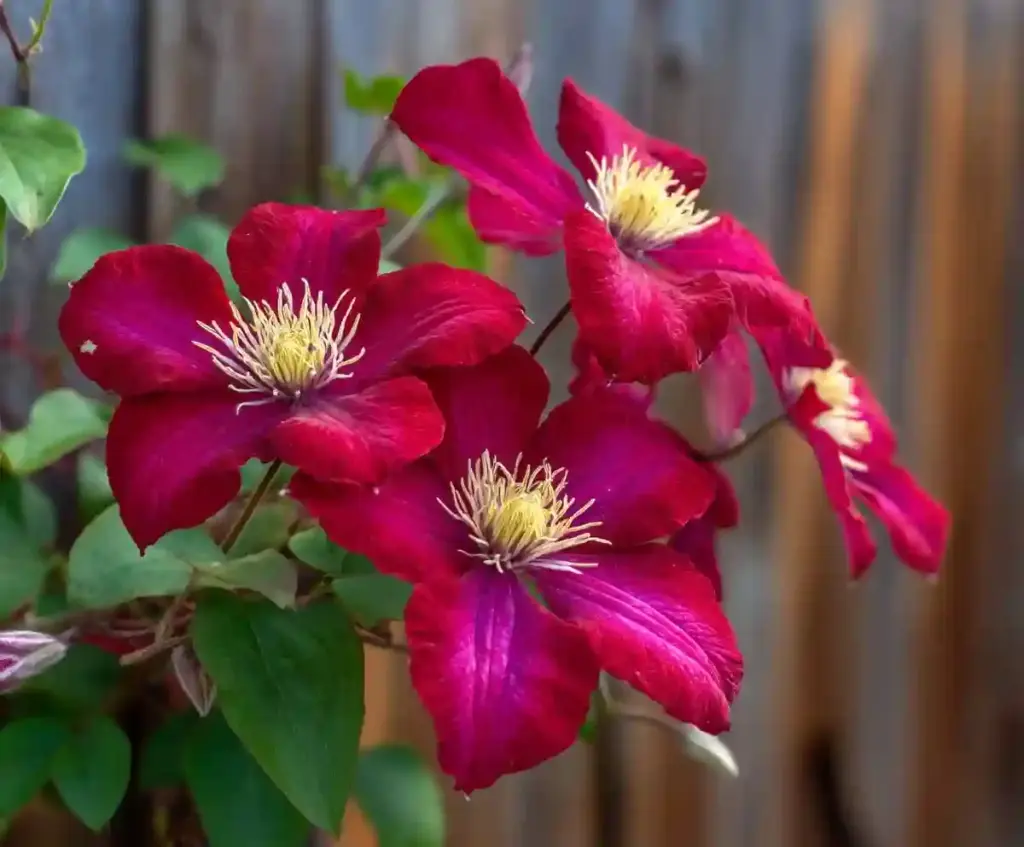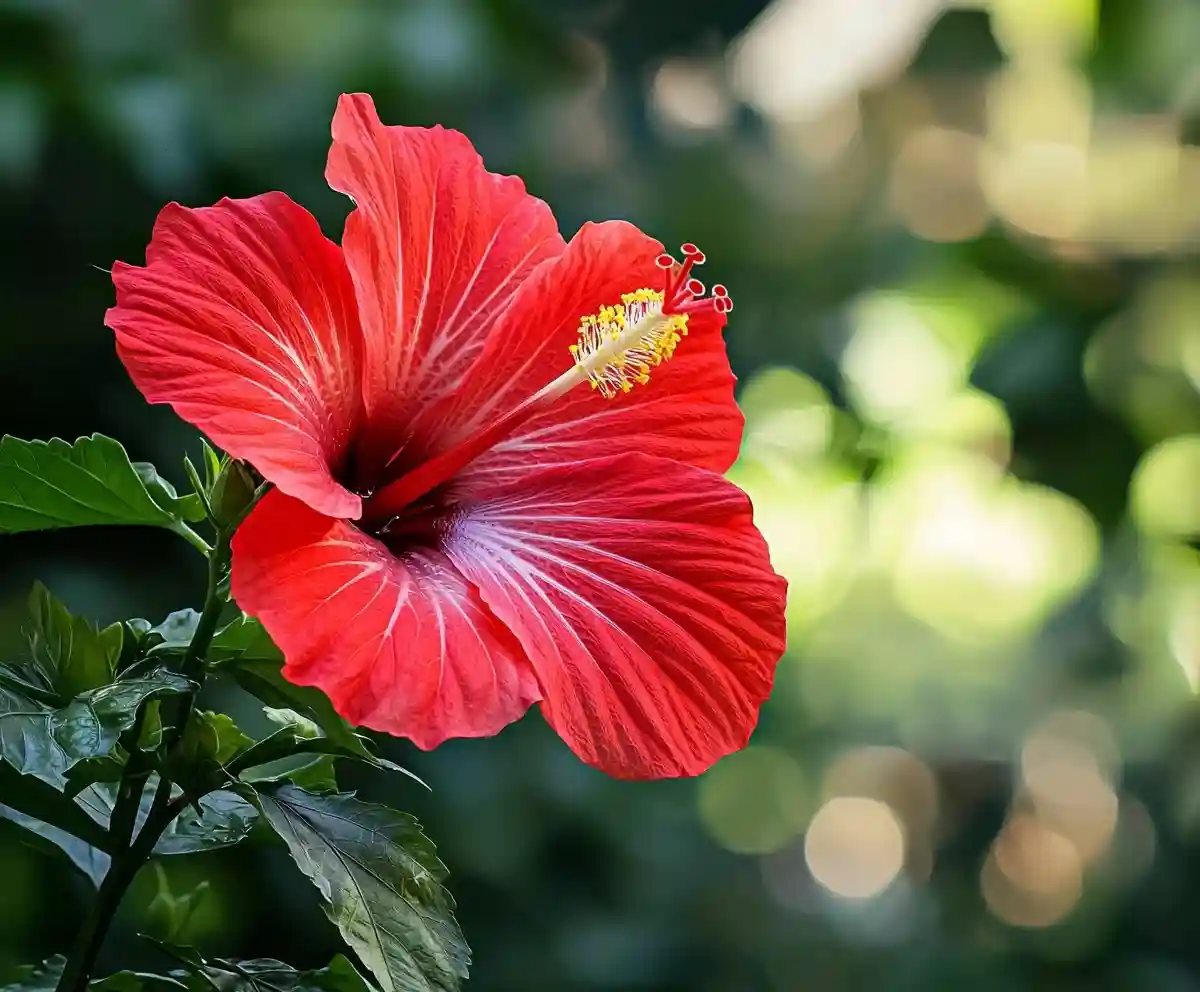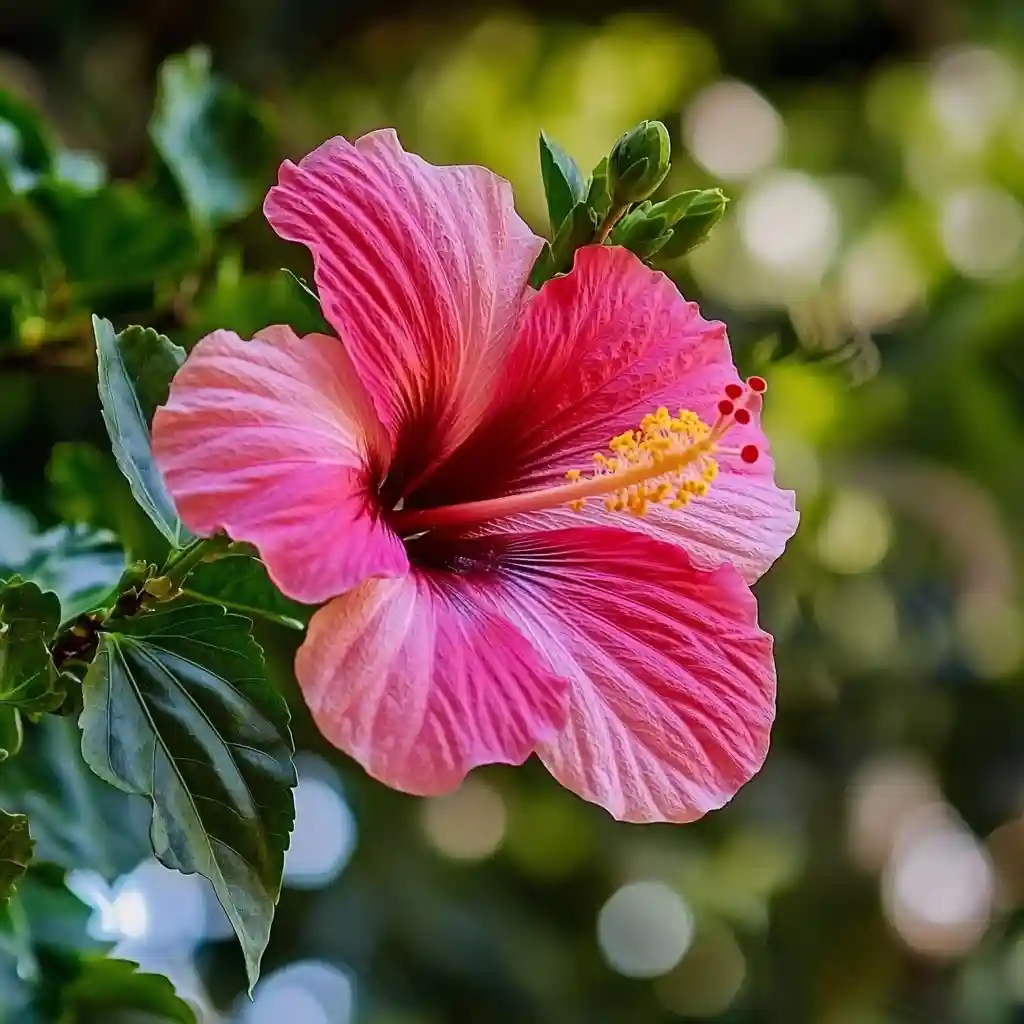Stunning types of hibiscus bring vibrant splashes of color and tropical elegance to gardens around the world. With their dazzling blooms, these beloved flowering plants offer more than just beauty—they’re hardy, diverse, and surprisingly easy to grow. Whether you’re designing a lush backyard oasis or adding flair to a container garden, hibiscus varieties can transform any outdoor space into a floral paradise.
From towering tropical shrubs to compact hybrids bursting with color, hibiscus comes in an array of shapes, sizes, and hues. In this guide, we’ll explore the most striking types of hibiscus that deserve a place in your garden. Each one offers its own unique charm—from color-shifting petals to gigantic blooms that attract pollinators all summer long.
Table of Contents
1. Hawaiian Hibiscus
The Hawaiian hibiscus is one of the most stunning types of hibiscus, known for its breathtaking flowers and tropical personality. As the state flower of Hawaii, this variety features large, radiant blooms in hues ranging from buttery yellow to fiery red. Its blossoms can measure up to 6 inches wide, creating a show-stopping presence in gardens and landscapes.
These tropical shrubs grow vigorously in warm climates, reaching heights between 4 to 16 feet with proper care. Hawaiian hibiscus thrives in full sun and moist, well-draining soil. When grown in ideal conditions, it produces continuous blooms that brighten outdoor spaces almost year-round.
Gardeners love using this variety as a natural privacy screen or focal point in tropical-themed gardens. Native Hawaiians have long used the flowers in traditional leis and ceremonies, showcasing the plant’s deep cultural significance.
For best results:
- Sunlight: Full sun (6+ hours/day)
- Water: Keep soil consistently moist but not soggy
- Zones: USDA 9–11
🌿 Pro tip: Pair with plumeria or bird of paradise for a lush, island-inspired garden aesthetic.
2. Sea Hibiscus
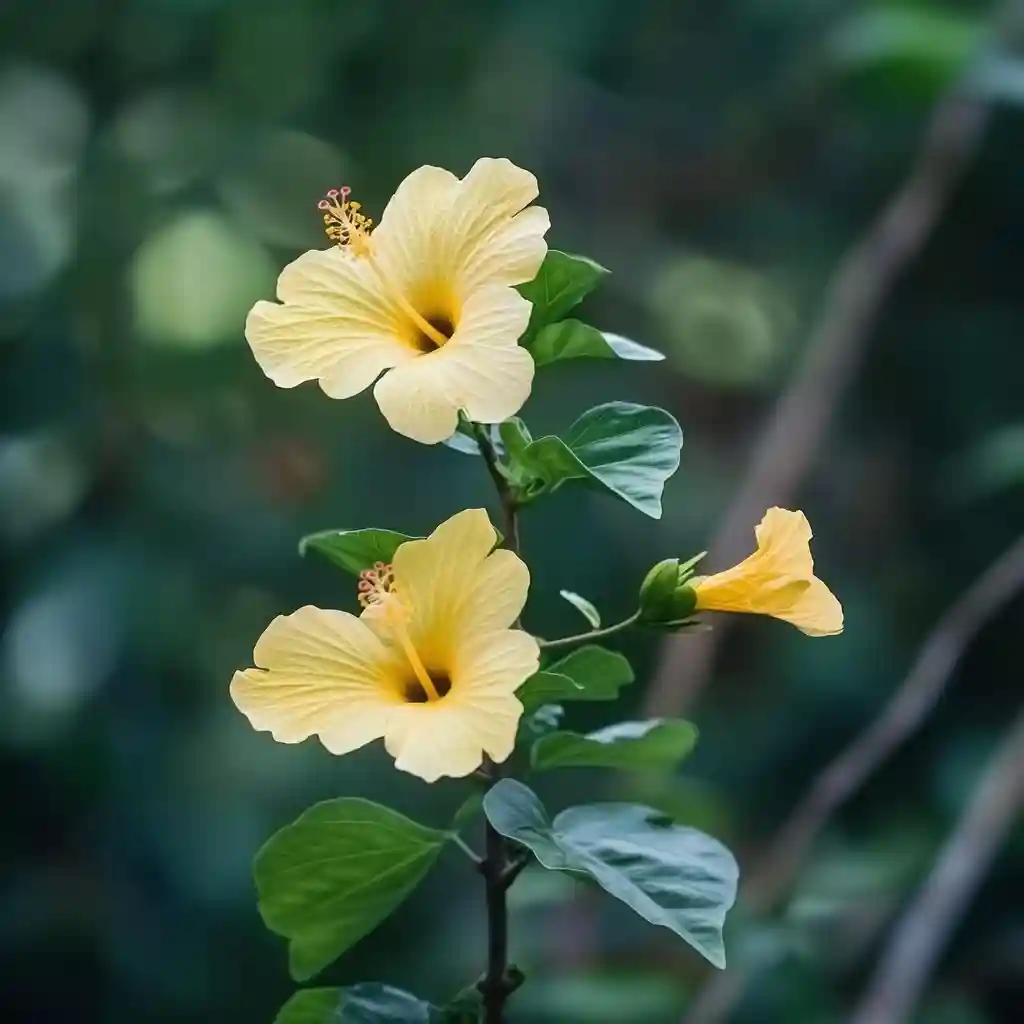
Among the most stunning types of hibiscus, the sea hibiscus (Hibiscus tiliaceus) offers a unique coastal charm. Native to tropical shores across Asia and the Pacific, this hibiscus stands out with its buttery yellow flowers that gently shift to orange or red as they age—adding dynamic color throughout the day.
One of its most distinctive features is the large, heart-shaped leaves in rich green tones, which provide dense foliage ideal for hedging or natural privacy screens. Sea hibiscus can grow into small trees or large shrubs, often reaching 10 to 15 feet tall, with a wide, spreading canopy.
It’s a favorite among coastal gardeners because of its remarkable salt and wind tolerance, making it perfect for seaside landscapes. Additionally, its flexible branches and striking leaf shape have earned it a place in traditional Pacific Island weaving and crafts.
Key growing tips:
- Sunlight: Full sun to partial shade
- Soil: Tolerates sandy, saline soil
- Zones: USDA 9–11
- Bonus: Suitable for bonsai due to its flexible stems and compact growth
🌱 Add sea hibiscus near water features or patios for a breezy, tropical feel that handles coastal elements with ease.
3. Black Dragon
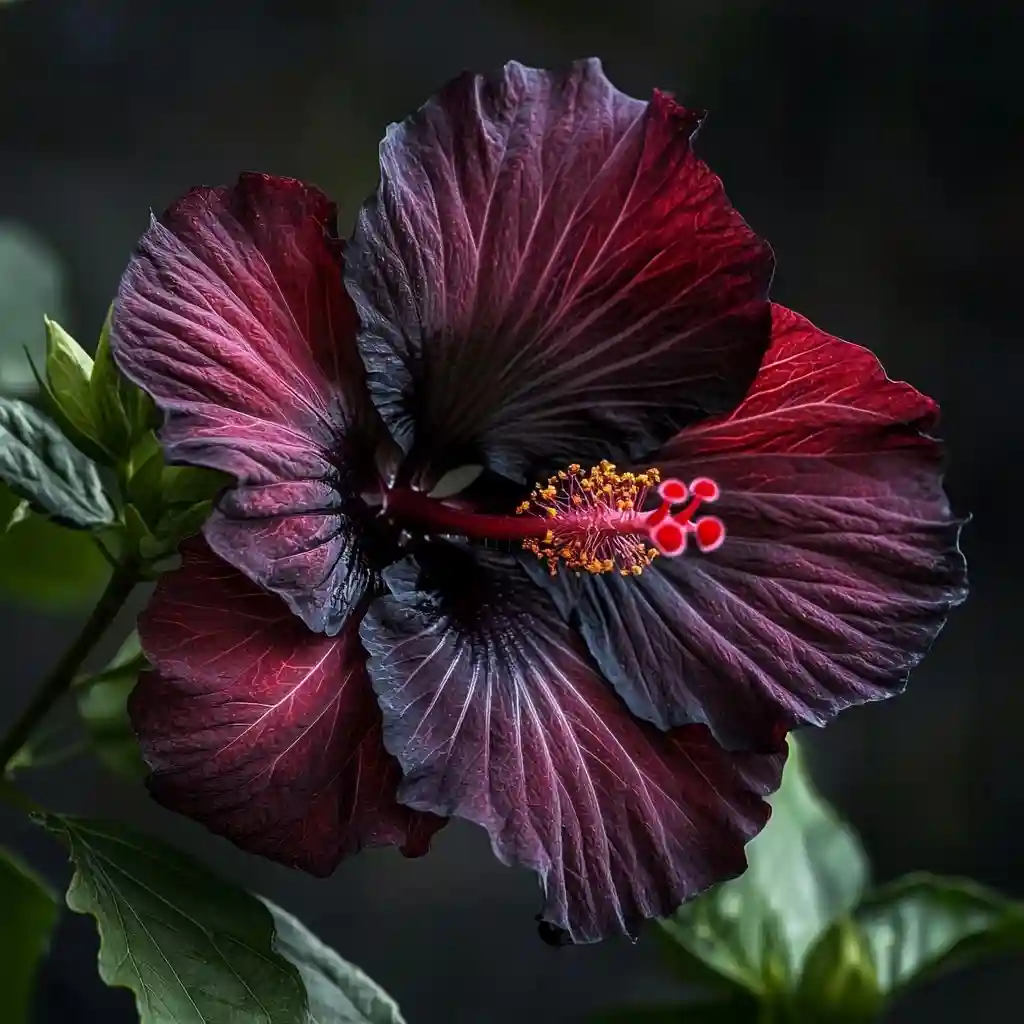
When it comes to stunning types of hibiscus, the Black Dragon variety brings pure drama to any garden. Its velvety, deep burgundy blooms almost appear black in certain lighting, creating a bold, gothic elegance that’s rare in the plant world. Each ruffled flower reaches up to 6 inches across, commanding attention wherever it grows.
Black Dragon belongs to the Hibiscus rosa-sinensis species and thrives in warm, humid environments. This compact, upright shrub typically grows 3 to 6 feet tall, making it ideal for borders, containers, or focal points in tropical garden beds.
Gardeners prize this variety not only for its eye-catching petals but also for its prolific blooming habit during the warm months. It’s a favorite among collectors and hybrid enthusiasts, often recognized in hibiscus shows for its unique coloration.
Growing tips for success:
- Sunlight: Full sun for rich color and abundant blooms
- Water: Keep soil moist, especially during flowering season
- Zones: USDA 9–11
- Maintenance: Prune in early spring to encourage bushier growth
🌸 Use Black Dragon as a statement plant in modern or dark-foliage-themed gardens for bold contrast.
4. Beach Beauty

True to its name, Beach Beauty is one of the most stunning types of hibiscus you can grow for vibrant, tropical flair. Its massive 6–8 inch blooms explode in a fiery display—featuring bright red centers that fade into golden orange and pink along the petal edges. The high-contrast colors give this variety a truly radiant look, especially under direct sunlight.
Beach Beauty is a tropical hybrid that thrives in warm, sunny conditions. It can grow as a large shrub, typically reaching 6 to 10 feet tall, or be maintained smaller with regular pruning. Thanks to its showy blooms and upright habit, it’s often used as a standalone specimen or planted in groups for maximum impact.
This hibiscus isn’t just eye candy—it’s also a magnet for butterflies and hummingbirds. Its long blooming season stretches from late spring to early fall, making it a dependable source of color and life in the garden.
What Beach Beauty needs:
- Sunlight: Full sun is essential for vibrant blooms
- Soil: Rich, well-drained soil
- Zones: USDA 9–11
- Bonus: Responds well to fertilization during active growth
🌴 Pair Beach Beauty with other warm-toned hibiscus like Mango Liqueur or Bedazzled for a blazing tropical garden design.
5. Rose of Sharon

A classic favorite among gardeners, the Rose of Sharon is one of the most widely grown and stunning types of hibiscus. Unlike its tropical cousins, this cold-hardy species (Hibiscus syriacus) can thrive in a variety of climates, making it a versatile option for gardens across USDA zones 5–9.
Rose of Sharon produces an abundance of blooms in late summer and early fall when many other plants start fading. Its flowers come in an array of shades—purple, pink, white, and even blue-tinted varieties—with either single or double petal formations. The upright, vase-shaped shrub can reach 8–12 feet tall and 4–6 feet wide, making it perfect for privacy hedges or backdrops in mixed borders.
Low-maintenance and resilient, this variety tolerates urban conditions, drought, and clay soil. It attracts bees, butterflies, and hummingbirds, bringing movement and life into the garden.
Why gardeners love it:
- Sunlight: Full sun to partial shade
- Soil: Adaptable but prefers well-drained soil
- Zones: USDA 5–9
- Maintenance: Prune in early spring to shape and promote flowering
🦋 Add Rose of Sharon to pollinator gardens or cottage-style landscapes for long-lasting late-season color.
6. Hibiscus Tricolor

Hibiscus Tricolor lives up to its name with dazzling, variegated foliage that makes it one of the most stunning types of hibiscus—even before it blooms. Its leaves are splashed with creamy white, pink, and green tones, creating a tropical mosaic effect. When deep red or magenta flowers emerge, they offer an eye-catching contrast against the already colorful backdrop.
Unlike larger tropical varieties, Hibiscus Tricolor stays relatively compact, usually reaching 4 to 6 feet tall. This makes it ideal for patio containers, ornamental hedging, or adding unique foliage interest to tropical-themed beds. It’s not just the flowers that turn heads—this variety is prized as much for its leaves as for its blooms.
Gardeners appreciate this plant for its adaptability. It performs well in both full sun and partial shade, although brighter light intensifies the leaf variegation.
Growing guidelines:
- Sunlight: Bright light, full sun for best foliage color
- Soil: Moist but well-drained
- Zones: USDA 9–11
- Best Use: Decorative specimen plant or focal point in a mixed border
🎨 Combine Hibiscus Tricolor with solid green or silver-foliaged plants to highlight its unique, multicolored leaves.
7. Luna Red
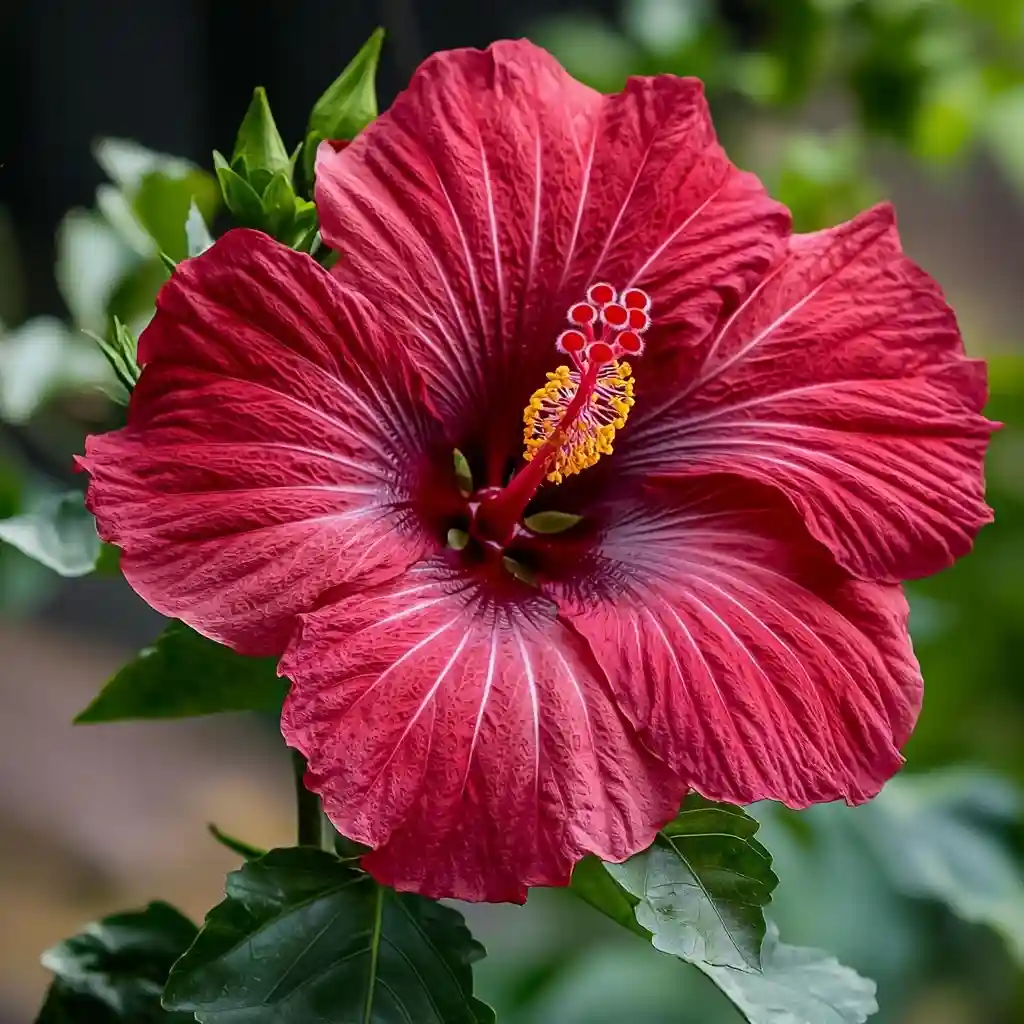
Compact yet bold, Luna Red is among the most stunning types of hibiscus for gardeners seeking deep color in a manageable size. This hardy perennial variety is known for its enormous, wine-red blooms that can reach up to 8 inches wide, creating an intense focal point in borders, containers, or small garden beds.
Unlike many tropical hibiscus varieties, Luna Red belongs to the Hibiscus moscheutos species, making it more tolerant of colder climates. It typically grows to a height of 3 to 4 feet, forming a neat, bushy mound. Despite its compact nature, its rich, velvety flowers rival those of larger cultivars in beauty and drama.
One of its standout features is its late-summer bloom period, when most other plants are winding down. It thrives in sunny, moist environments and comes back stronger each year.
Quick care tips:
- Sunlight: Full sun for best flower production
- Soil: Moist, well-drained, slightly acidic
- Zones: USDA 5–9
- Water: Keep soil evenly moist, especially during hot months
🌺 Plant Luna Red in mass groupings for a bold sweep of crimson or pair it with white-blooming varieties like Blue River II for contrast.
8. Blue Bird
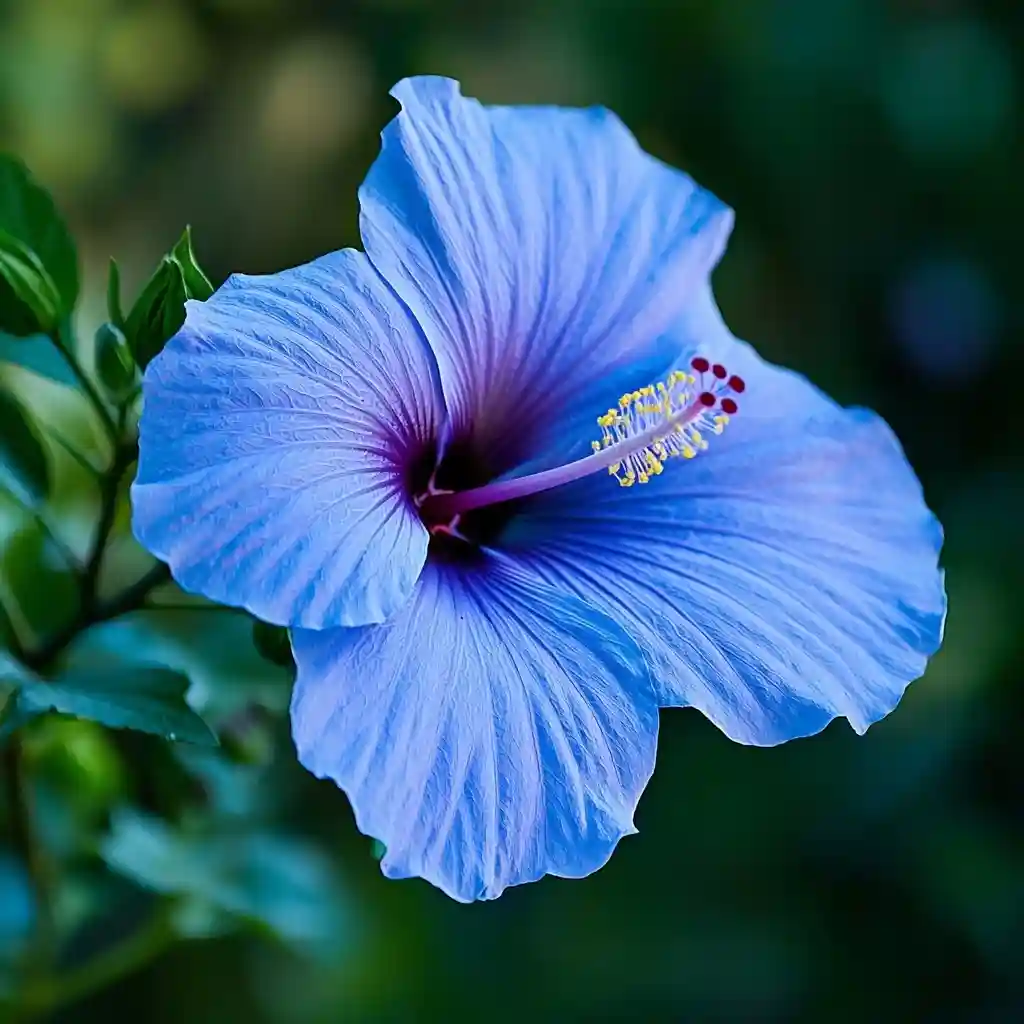
The Blue Bird hibiscus stands out as one of the most stunning types of hibiscus for its rare and mesmerizing color: a soft lavender-blue bloom with a dark maroon center. This cultivar of Hibiscus syriacus brings a cool-toned elegance to gardens, especially when paired with warmer-colored flowers for contrast.
Blue Bird is a hardy, deciduous shrub that typically grows 6 to 8 feet tall and 4 to 6 feet wide. It’s ideal for hedges, foundation plantings, or as a specimen shrub. It blooms from mid-summer into fall, delivering a steady stream of flowers when many other plants begin to fade.
One of the most appealing qualities of Blue Bird is its resilience. It thrives in a variety of soils, tolerates heat and drought once established, and even endures urban pollution—making it a reliable choice for city gardens and suburban landscapes alike.
At-a-glance care:
- Sunlight: Full sun to partial shade
- Soil: Adaptable, but prefers well-drained soil
- Zones: USDA 5–9
- Bonus: Attracts hummingbirds and butterflies
💙 Use Blue Bird to create soothing color schemes in pollinator gardens or cottage borders alongside white phlox, lavender, or salvia.
9. Secret Heart
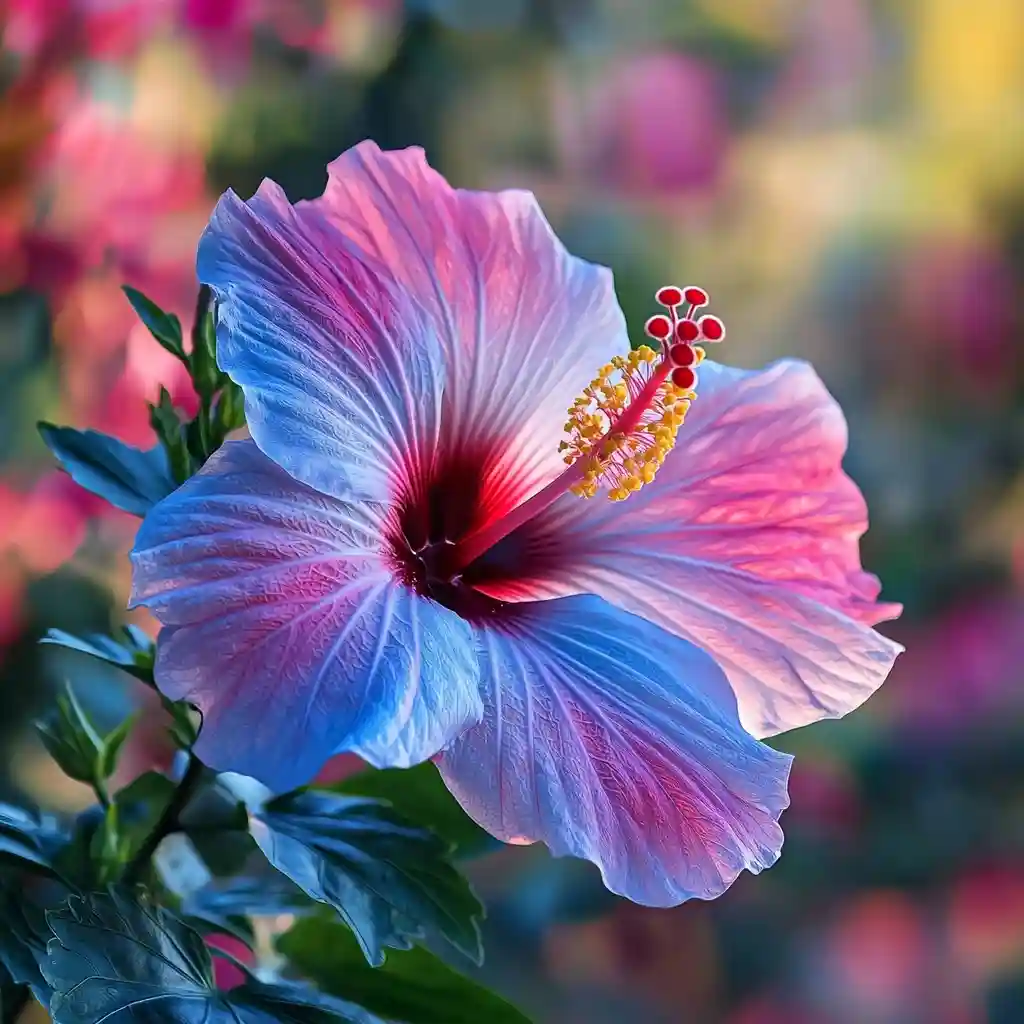
Secret Heart is one of the most stunning types of hibiscus you can grow if you’re after drama, color-shifting magic, and conversation-starting beauty. This hybrid variety is renowned for its dynamic petals that change color based on light and temperature—blending rich pinks, reds, and subtle hints of blue or purple throughout the day.
Its large, five-petaled flowers open to reveal bold centers that pulse with color intensity, often appearing different each morning. The shrub typically grows to 4–6 feet tall and wide, with glossy green foliage that provides a lush backdrop for its ever-changing blooms.
Secret Heart is a relatively new cultivar, bred from carefully selected parent plants to maximize visual impact and blooming consistency. It’s a tropical hibiscus that thrives in warm climates and performs best with regular feeding and plenty of sun.
Essentials for success:
- Sunlight: Full sun boosts color vibrancy
- Soil: Fertile, well-drained, slightly acidic
- Zones: USDA 9–11
- Water: Keep consistently moist, but avoid soggy roots
💫 Place Secret Heart near walkways or patios where its color shifts can be enjoyed up close throughout the day.
10. Kenaf
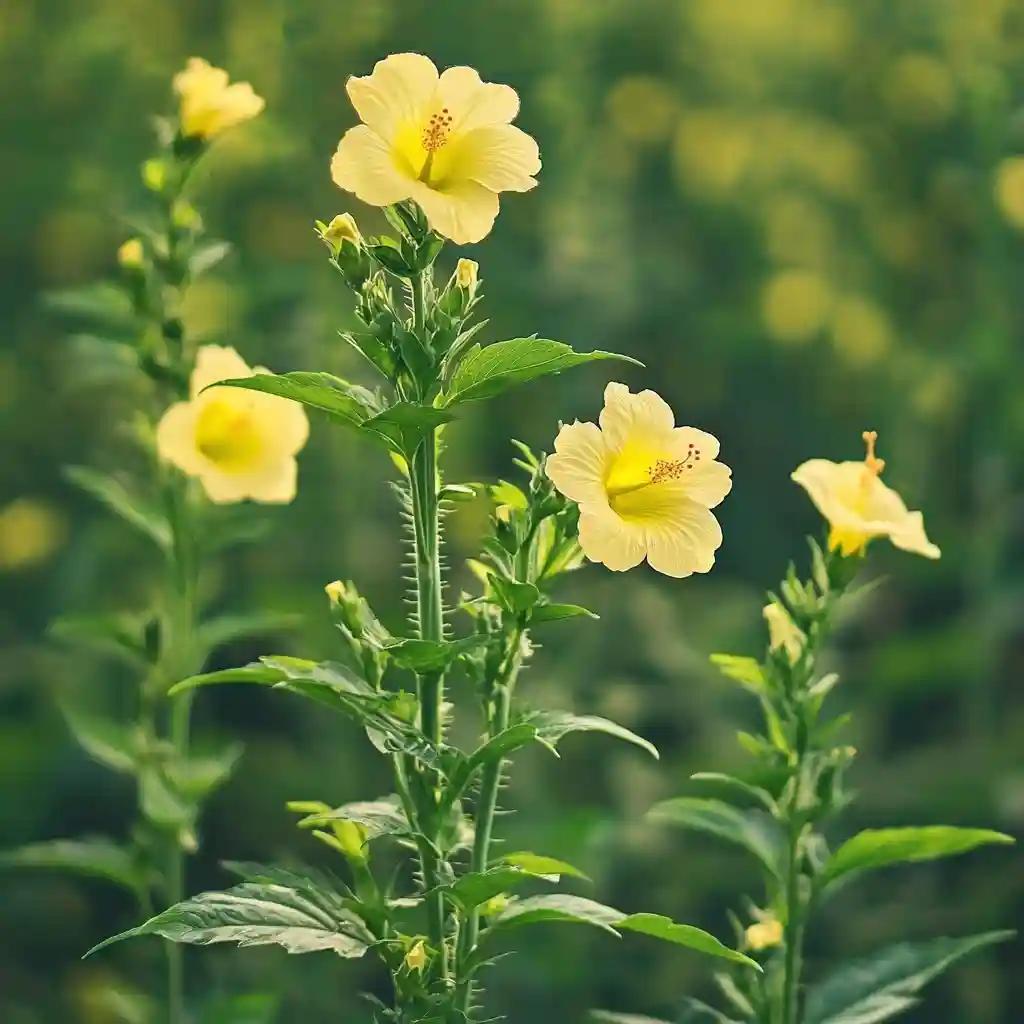
Kenaf may not be the first plant that comes to mind when thinking of stunning types of hibiscus, but this unique species (Hibiscus cannabinus) offers both beauty and utility. Known for its tall, upright habit and soft, pale yellow flowers with dark maroon centers, Kenaf blends ornamental value with industrial use—making it a standout in more ways than one.
This fast-growing annual can soar up to 12 feet tall in just a single season, creating a bold vertical accent in gardens. Its slender, serrated leaves resemble those of cannabis, and its fibrous stalks have been used for centuries to make rope, textiles, and even biodegradable packaging.
In garden settings, Kenaf is appreciated for its bold structure, subtle blooms, and ability to attract pollinators. It thrives in hot, sunny environments and makes an excellent backdrop or privacy screen in larger landscapes.
How to grow Kenaf successfully:
- Sunlight: Full sun for rapid growth
- Soil: Well-drained, fertile soil
- Zones: USDA 8–11 (grow as an annual in cooler zones)
- Water: Moderate; drought-tolerant once established
🌾 Use Kenaf to add vertical interest in tropical gardens or to support eco-conscious landscaping projects.
11. Lord Baltimore
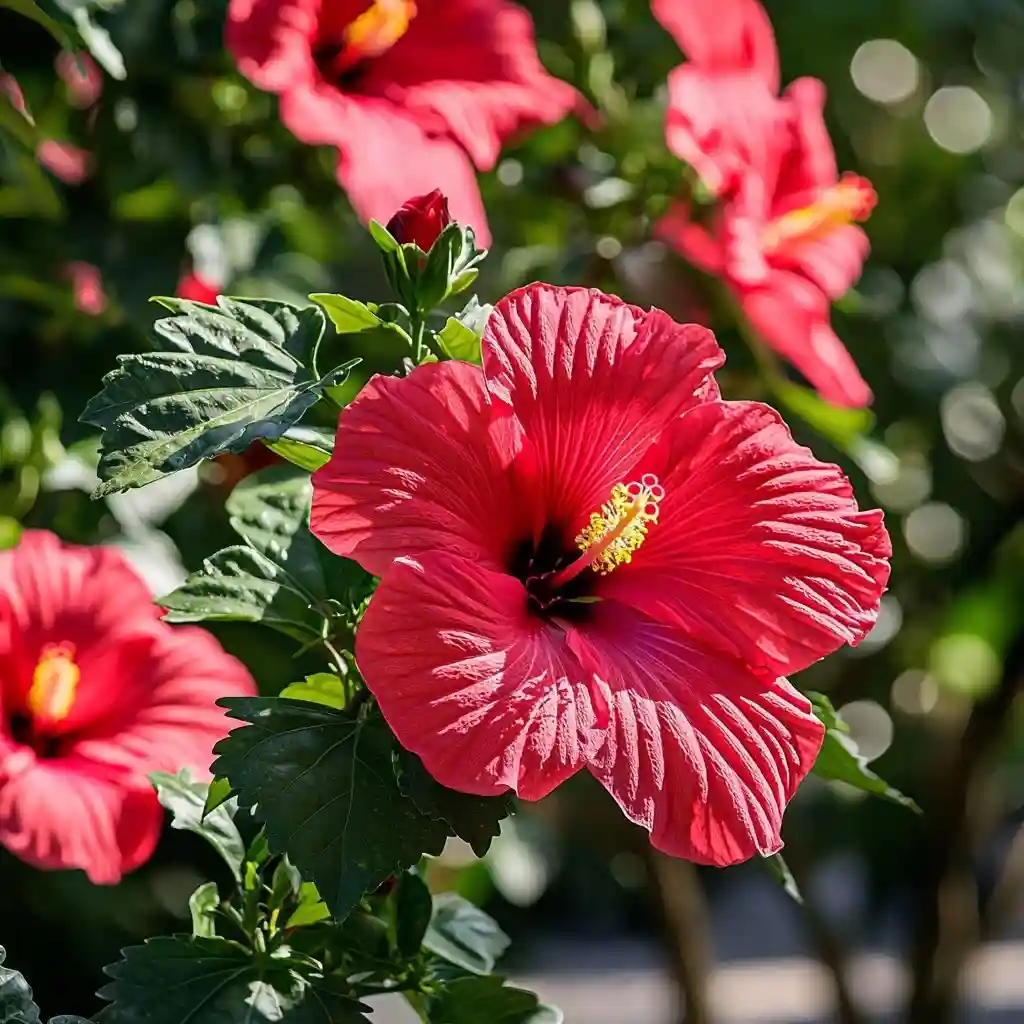
If you’re seeking bold garden drama, Lord Baltimore is one of the most stunning types of hibiscus you can plant. This cold-hardy perennial variety is famous for its enormous, crimson-red blooms that can span up to 10 inches across. Each flower lasts only a day, but the plant produces so many that your garden will glow with color for weeks.
Lord Baltimore is part of the Hibiscus moscheutos group, which means it’s not only gorgeous but also tough. It dies back to the ground in winter, then shoots up rapidly each spring, forming a 4- to 5-foot-tall shrub with a tidy, upright shape. Its glossy, maple-like leaves provide contrast to the intense red blossoms that appear in mid-to-late summer.
This variety is a favorite for cottage gardens, perennial borders, and pollinator-friendly designs, where butterflies and hummingbirds visit daily.
Growing Lord Baltimore:
- Sunlight: Full sun (essential for large blooms)
- Soil: Moist, rich, and well-draining
- Zones: USDA 5–9
- Water: Requires consistent watering—do not allow to dry out
❤️ Pair Lord Baltimore with ornamental grasses or white-flowered perennials for a high-impact, high-contrast garden bed.
12. Confederate Rose
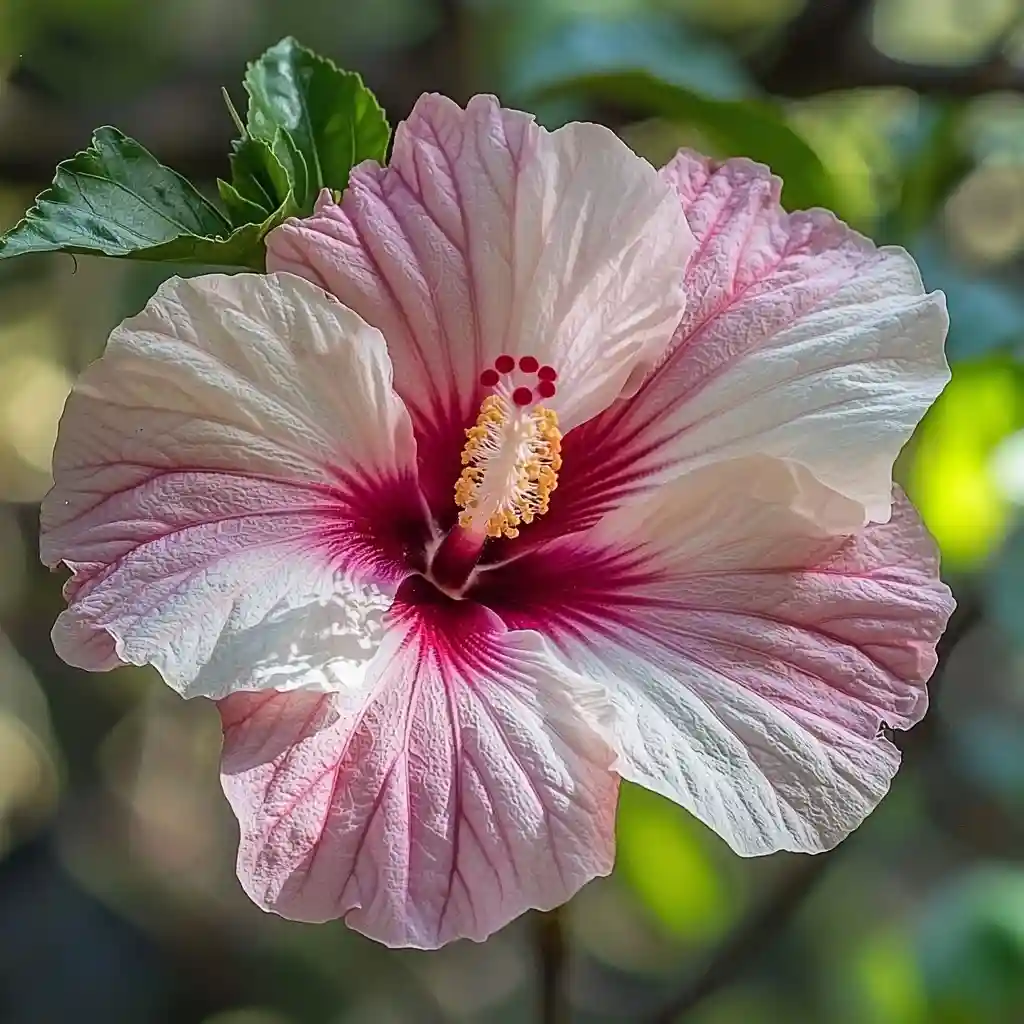
The Confederate Rose is easily one of the most stunning types of hibiscus, not just for its large, peony-like flowers but for its enchanting ability to change color throughout the day. Each bloom opens in the morning as pure white, gradually shifts to soft pink by midday, and deepens to rich rose-red by evening—all on the same flower. This natural color transformation adds a magical quality to any garden.
A member of the Hibiscus mutabilis species, the Confederate Rose is technically a large shrub or small tree. In warm climates, it can grow up to 12 feet tall with a wide-spreading form. Its deeply lobed leaves resemble those of a maple, and its impressive flower clusters bloom profusely from late summer into fall.
Despite its tropical looks, it’s surprisingly hardy in USDA zones 7–10. In cooler zones, it behaves more like a perennial, dying back in winter and regrowing in spring.
Key growing needs:
- Sunlight: Full sun to light shade
- Soil: Moist, well-drained, fertile soil
- Zones: USDA 7–10
- Water: Moderate; avoid letting the soil dry out completely
🌅 For the best visual impact, plant Confederate Rose near outdoor seating areas where its daily color changes can be appreciated up close.
13. Rock Hibiscus

Among the most stunning types of hibiscus, Rock Hibiscus (Hibiscus denudatus) is a true desert gem. Native to arid regions of the American Southwest and northern Mexico, this hardy species stands out with its soft pastel flowers—ranging from lavender and light pink to pale white—set against gray-green, triangular leaves.
What makes Rock Hibiscus so captivating is its ability to thrive in the harshest conditions. It grows in rocky outcrops, canyon walls, and dry slopes, blooming prolifically even in drought-prone environments. Its compact, woody form typically stays under 3 feet tall, making it ideal for xeriscaping and native plant gardens.
The flowers are delicate in appearance but surprisingly resilient, often attracting bees, native pollinators, and butterflies. This low-maintenance plant offers understated beauty and serves as a reminder of how stunning desert-adapted plants can be.
Desert-friendly care tips:
- Sunlight: Full sun is a must
- Soil: Sandy, rocky, well-draining
- Zones: USDA 8–11
- Water: Very drought-tolerant once established
🌵 Use Rock Hibiscus in desert landscapes, rock gardens, or water-wise designs where subtle beauty and resilience are equally valued.
14. China Rose

The China Rose (Hibiscus rosa-sinensis) is the poster child of tropical gardens and certainly one of the most stunning types of hibiscus. With a wide range of colors—including fiery red, sunshine yellow, coral pink, and even multicolored varieties—it’s no surprise this species is beloved around the world. The single or double blooms are often ruffled, with bright, contrasting centers that make each flower feel like a masterpiece.
China Rose is an evergreen shrub that grows 4 to 10 feet tall, depending on pruning and climate. It’s highly versatile and can be used in containers, hedges, or as a lush ornamental in both home gardens and formal landscapes. In warmer climates, it can flower nearly year-round, offering continuous bursts of color and attracting hummingbirds and butterflies.
Beyond its ornamental appeal, China Rose has cultural and traditional significance. In parts of Asia, the flowers are used in herbal remedies and even to shine shoes—a testament to the plant’s diverse utility.
Care tips for tropical success:
- Sunlight: Full sun or light shade
- Soil: Rich, well-drained, slightly acidic
- Zones: USDA 9–11
- Water: Keep soil evenly moist, but never soggy
🌺 China Rose pairs beautifully with palms, ginger, and plumeria for a full tropical garden effect that feels like paradise.
15. Bedazzled
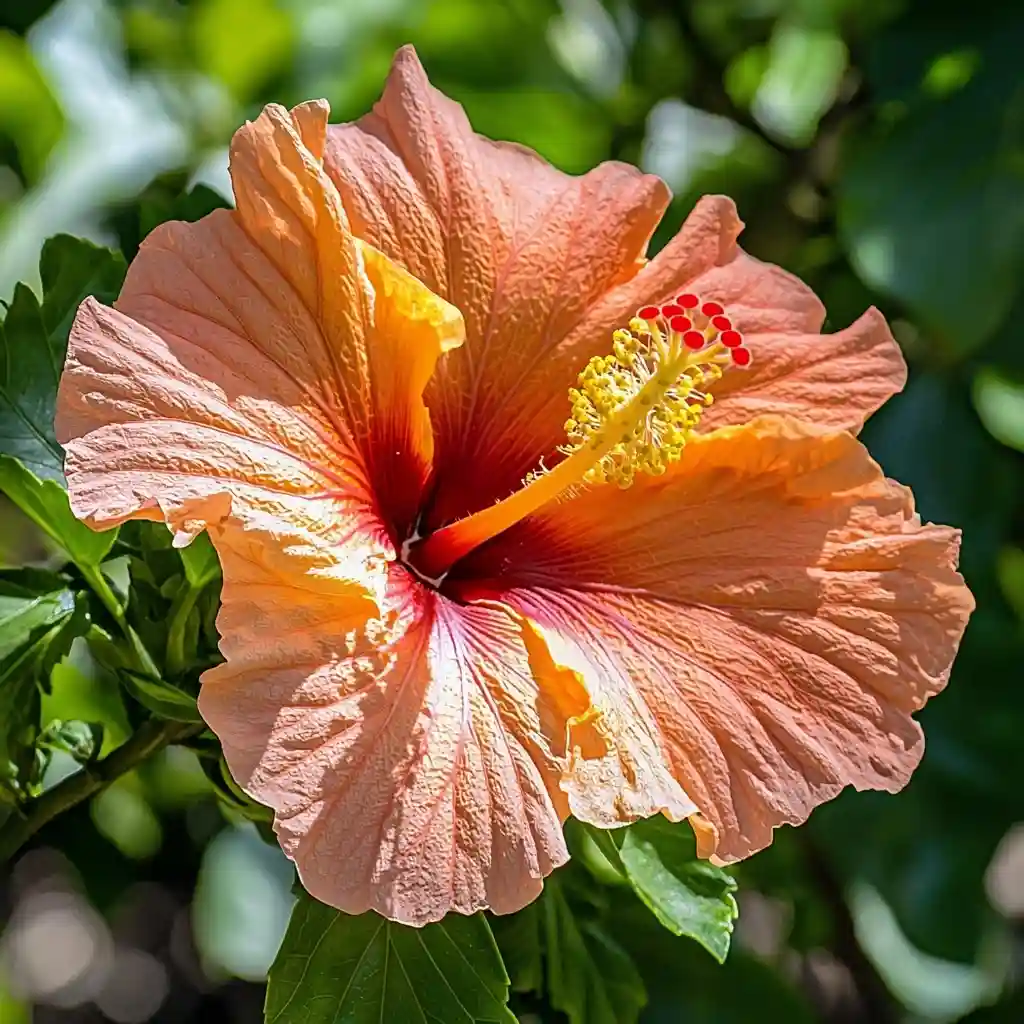
True to its name, Bedazzled is one of the most stunning types of hibiscus, dazzling gardeners with oversized, ruffled blooms that radiate fiery orange and coral tones. This tropical hybrid is a visual spectacle, with flowers that span 6 to 8 inches wide, catching sunlight in ways that make the petals appear almost luminous.
Bedazzled was developed by crossing high-performance cultivars like ‘Tis Huge’ and ‘Standing Ovation’, resulting in a hardy, heat-tolerant plant that thrives in hot, sunny environments. It typically grows 4 to 6 feet tall, forming a dense, rounded shrub that works well as a specimen plant or in tropical borders.
While it needs consistent warmth and humidity to thrive, its vibrant coloration and strong growth make it worth the effort in suitable climates. This variety is especially loved in southern gardens where heat and humidity are the norm.
Tips for growing Bedazzled:
- Sunlight: Full sun intensifies color and bloom size
- Soil: Well-draining, organically rich soil
- Zones: USDA 9–11
- Water: Regular watering; don’t let soil dry out
🔥 Plant Bedazzled in front yards or entryways where its vivid flowers can make a striking first impression.
16. Mango Liqueur
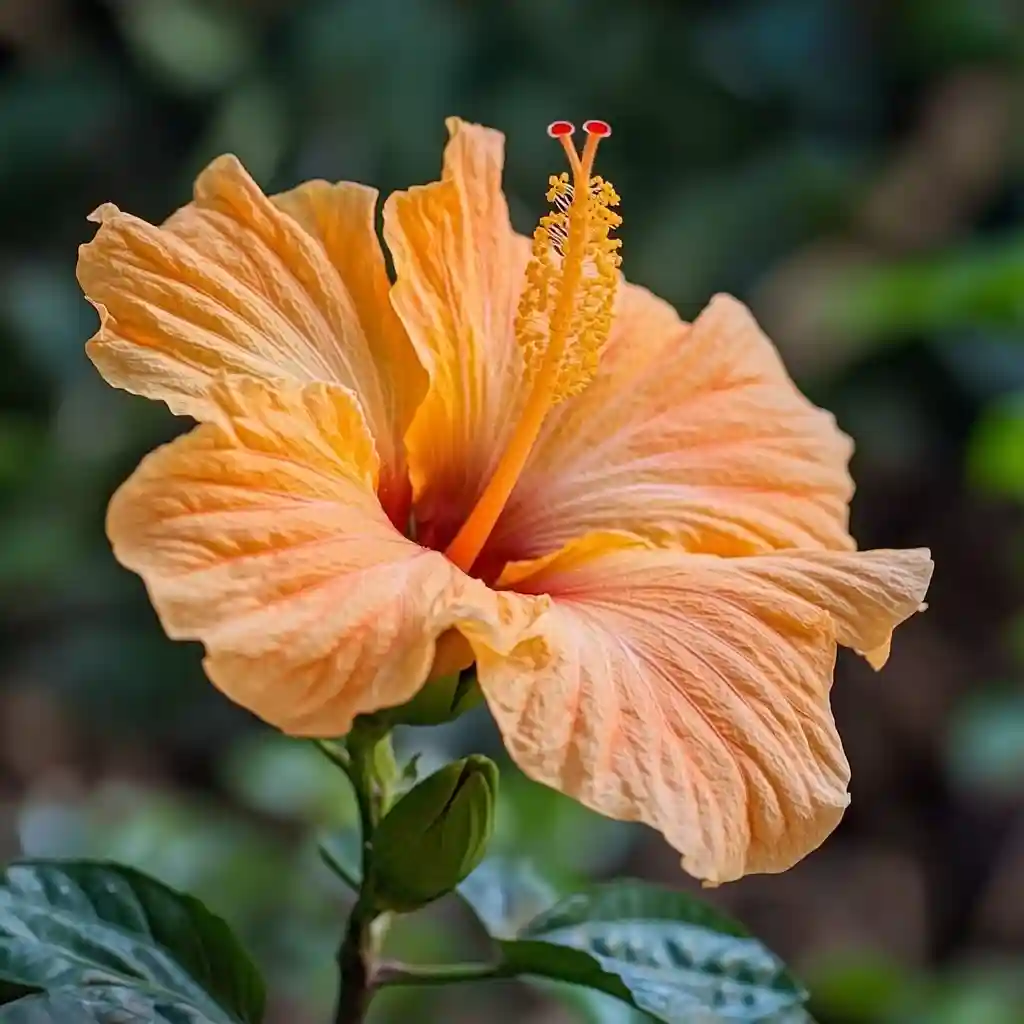
Mango Liqueur is easily one of the most stunning types of hibiscus for gardeners who love bold, sunset-inspired colors. Its large, ruffled flowers—measuring 6 to 8 inches across—blend rich orange and golden hues, often with a deeper red or coral center. The color combination mimics the warm tones of a tropical cocktail, making this plant a vibrant showpiece in any sunny garden.
This variety was developed by hybridizing standout cultivars such as ‘Muffin Man’ and ‘Crème de Cacao,’ resulting in a robust, tall-growing shrub that can reach 10 to 12 feet in ideal conditions. Mango Liqueur thrives in full sun, producing an abundance of blooms from late spring through early fall.
Its strong vertical growth makes it perfect for use as a privacy screen, focal point, or backdrop in tropical garden designs. The flowers attract hummingbirds and pollinators while offering long-lasting visual appeal.
How to care for Mango Liqueur:
- Sunlight: Full sun for best bloom output
- Soil: Fertile, well-drained, slightly acidic
- Zones: USDA 9–11
- Water: Keep soil consistently moist but not soggy
🍹 Pair Mango Liqueur with contrasting varieties like Blue Bird or Luna Pink Swirl for a vibrant, tropical palette.
17. Abelmosk
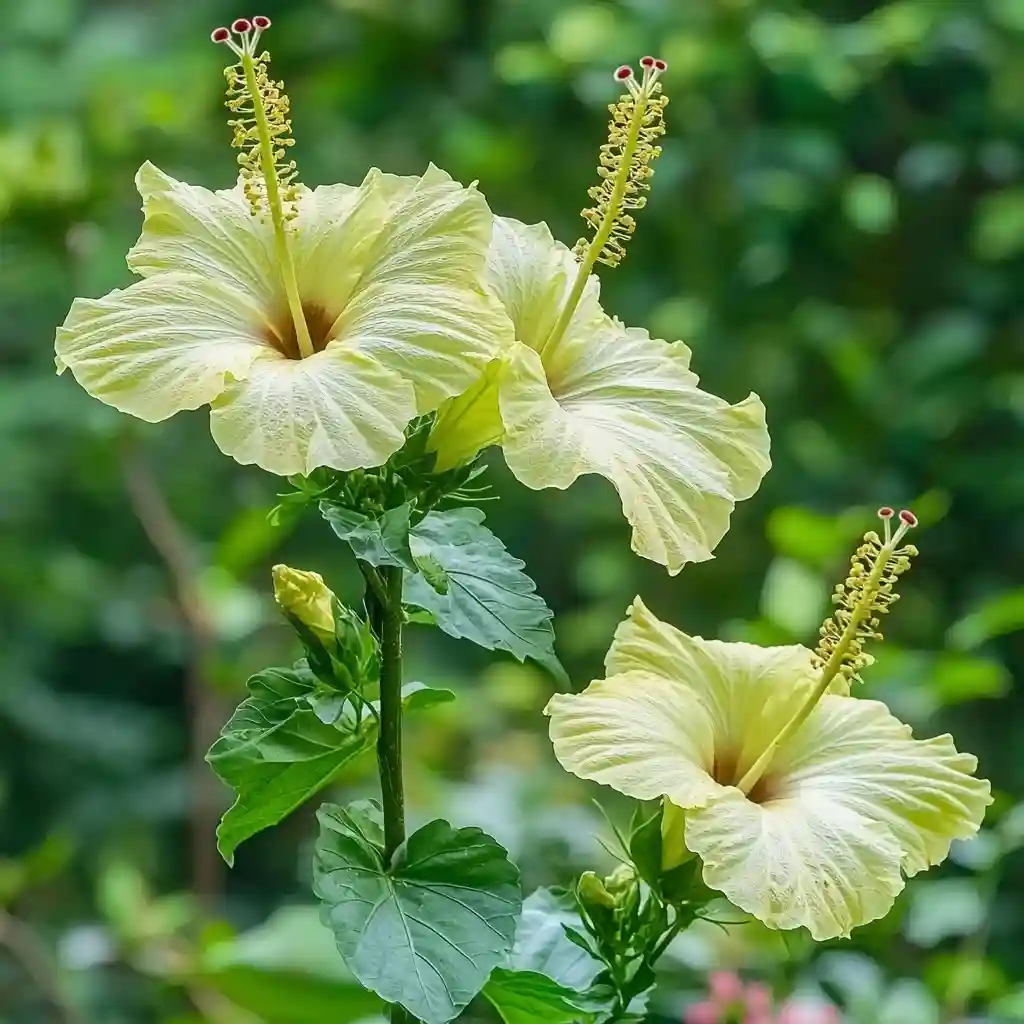
Abelmosk (Hibiscus abelmoschus), also known as musk mallow, is a lesser-known but truly stunning type of hibiscus that adds fragrance and intrigue to the garden. Unlike the flamboyant tropical varieties, Abelmosk captivates with soft yellow to lime-green flowers featuring dark maroon centers—and a surprising bonus: its seeds release a pleasant, musky aroma often used in perfumes and herbal teas.
Native to India and tropical Asia, Abelmosk grows as an annual or short-lived perennial in warm climates, reaching heights of 5 to 6 feet. It has deeply lobed leaves and an upright, branching habit that brings a soft, airy texture to garden beds or borders.
Aside from its ornamental value, Abelmosk is appreciated for its culinary and medicinal uses. Its seeds have been used in coffee blends and Ayurvedic remedies, while the flowers attract bees and other pollinators during their short bloom cycles.
How to grow Abelmosk:
- Sunlight: Full sun to light shade
- Soil: Moist, rich, and well-drained
- Zones: USDA 9–11 (grow as an annual in cooler zones)
- Water: Moderate, especially during flowering
🌼 Use Abelmosk in herb gardens, sensory gardens, or as a unique ornamental addition to tropical and subtropical beds.
18. Cranberry Hibiscus

Cranberry Hibiscus (Hibiscus acetosella) is one of the most visually striking and stunning types of hibiscus, thanks to its deep burgundy foliage that resembles Japanese maple leaves. While its yellow to reddish funnel-shaped flowers are charming in their own right, it’s the rich, wine-colored leaves that steal the show—adding dramatic contrast and texture to any landscape.
Native to Central and South America, this fast-growing shrub can reach 4 to 5 feet tall and is often grown as an annual in cooler regions. It’s perfect for gardeners looking to add bold foliage color without waiting years for maturity. The leaves are not only ornamental but also edible, with a tangy flavor similar to sorrel—ideal for adding a colorful twist to salads and teas.
Cranberry Hibiscus thrives in full sun and warm climates, producing flowers in late summer to early fall. Its ability to combine beauty, edibility, and easy maintenance makes it a favorite among edible landscape designers and tropical gardeners alike.
Care essentials:
- Sunlight: Full sun enhances leaf color
- Soil: Well-draining, moderately fertile
- Zones: USDA 8–11 (grown as an annual in cooler zones)
- Water: Moderate watering; drought-tolerant once established
🍷 Use Cranberry Hibiscus in ornamental edible gardens or mix it with bright green plants to create eye-catching contrast.
19. Roselle
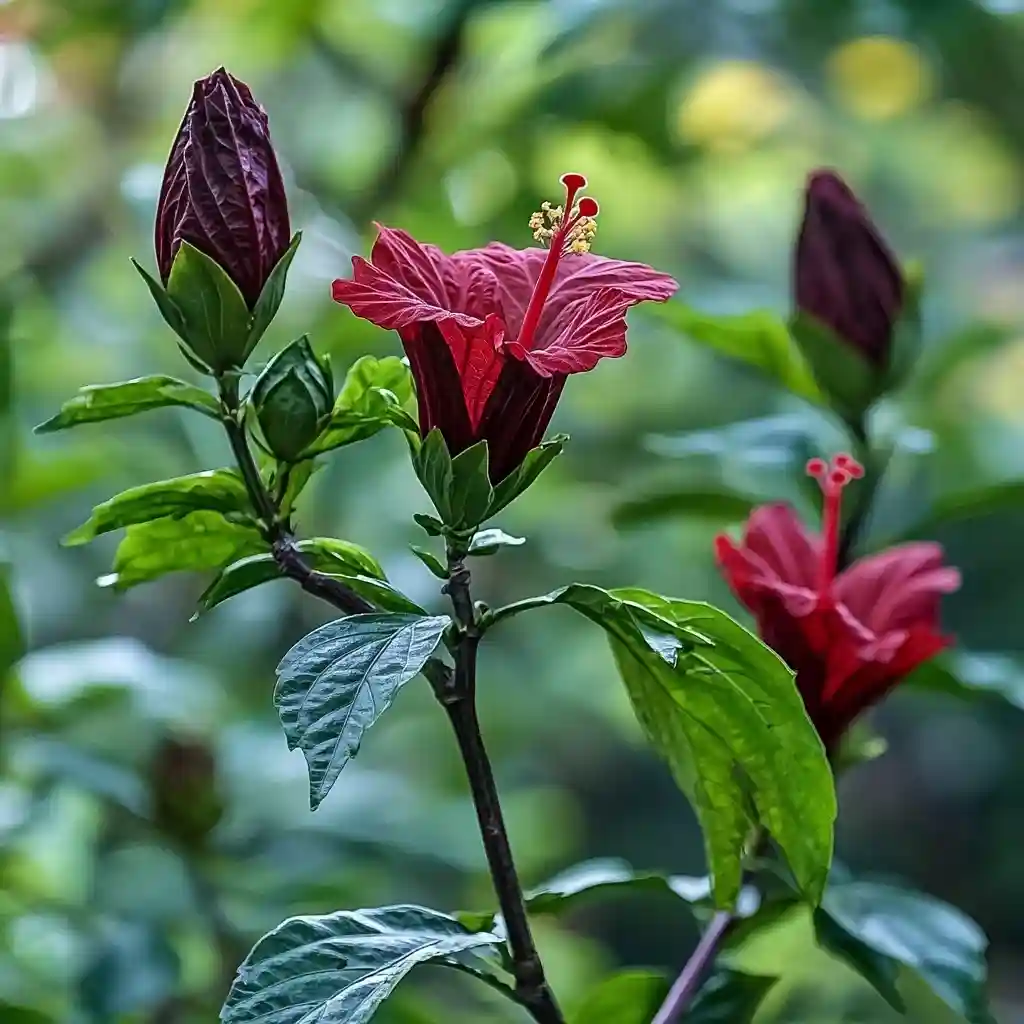
Roselle (Hibiscus sabdariffa) is both a beautiful ornamental and a powerhouse plant in the kitchen and herbal medicine cabinet—making it one of the most versatile and stunning types of hibiscus. It features bright red calyces (the fleshy part beneath the flower) that are used to make teas, jams, sauces, and the beloved Caribbean drink, sorrel.
The flowers themselves are pale yellow with dark red centers and bloom briefly before giving way to the edible calyces. Roselle grows quickly, forming bushy, upright plants that reach 6 to 8 feet tall in just one season. The stems are often a deep red, adding further visual interest, and the jagged-edged leaves provide texture to borders or kitchen gardens.
Native to Africa and Asia, Roselle thrives in tropical to subtropical regions and is prized not just for its looks but for its high vitamin C content and antioxidant properties.
Roselle growing tips:
- Sunlight: Full sun is essential
- Soil: Well-drained, fertile, and slightly acidic
- Zones: USDA 9–11 (grow as annual in cooler zones)
- Water: Regular moisture; don’t let it dry out
🍵 Grow Roselle in sunny herb gardens for a dual-purpose plant that’s as nourishing as it is beautiful.
20. Cherry Cheesecake
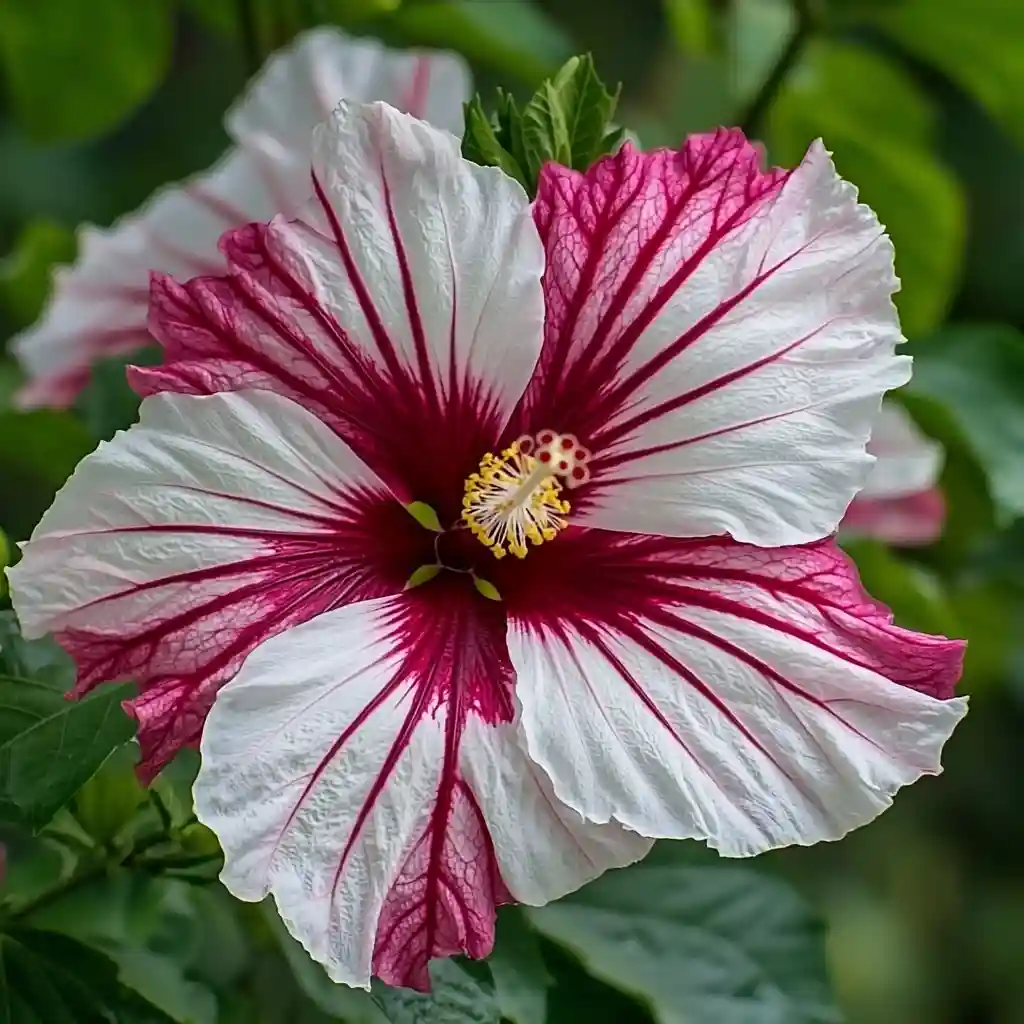
If you’re looking for one of the most visually dramatic and stunning types of hibiscus, Cherry Cheesecake will not disappoint. This hardy Hibiscus moscheutos variety showcases enormous 8–9 inch flowers with creamy white petals streaked with deep magenta veins and a bold cherry-red center—true to its delicious name. The contrast is so striking, it often looks hand-painted.
Cherry Cheesecake forms a compact, bushy clump reaching about 4 to 5 feet tall and wide. It begins blooming in mid-to-late summer and keeps the show going into early fall. Each flower only lasts a day or two, but the plant produces so many blooms that it stays covered in color for weeks.
Perfect for perennial borders, cottage gardens, or moist planting areas, this variety is also known for attracting hummingbirds and butterflies. Its cold hardiness and impressive flower size make it a standout in zones where tropical hibiscus can’t survive.
Cherry Cheesecake care guide:
- Sunlight: Full sun
- Soil: Moist, fertile, and well-drained
- Zones: USDA 4–9
- Water: Requires regular watering, especially during flowering
🍒 Use Cherry Cheesecake as a showpiece near walkways or patios, where its bold color patterns can be admired up close.
21. Scarlet Rosemallow
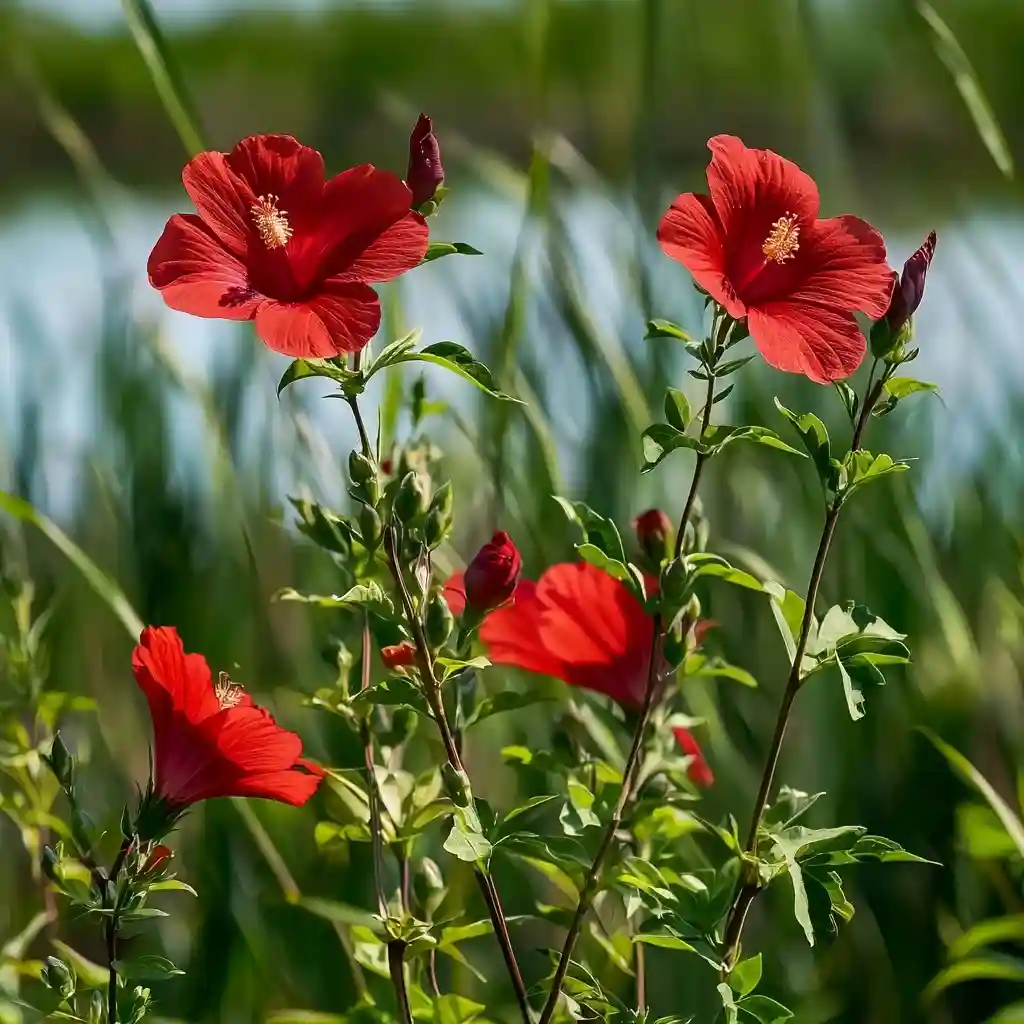
Scarlet Rosemallow (Hibiscus coccineus) is a wildflower native to the southeastern United States and one of the most naturally stunning types of hibiscus. Its star-shaped, brilliant crimson flowers span 3 to 5 inches wide and bloom atop tall, slender stems that can reach up to 7 feet in height. The dramatic, palmately divided leaves resemble cannabis foliage, adding a unique, architectural look to the garden.
Unlike many of its more tropical cousins, Scarlet Rosemallow is both cold-hardy and tolerant of wet conditions, thriving in swamps, marshes, and along pond edges. It blooms steadily from mid-to-late summer and is a magnet for butterflies and hummingbirds.
Gardeners love Scarlet Rosemallow for its sculptural form and bold color, making it an ideal choice for native plant landscapes, rain gardens, and naturalized settings. It performs beautifully in full sun and adds height and movement to perennial beds.
Grow it like this:
- Sunlight: Full sun is ideal
- Soil: Moist to wet, organically rich soil
- Zones: USDA 6–9
- Water: Loves consistent moisture
❤️ Plant Scarlet Rosemallow near water features, in rain gardens, or alongside ornamental grasses for a wild, yet elegant look.
22. Flower of an Hour
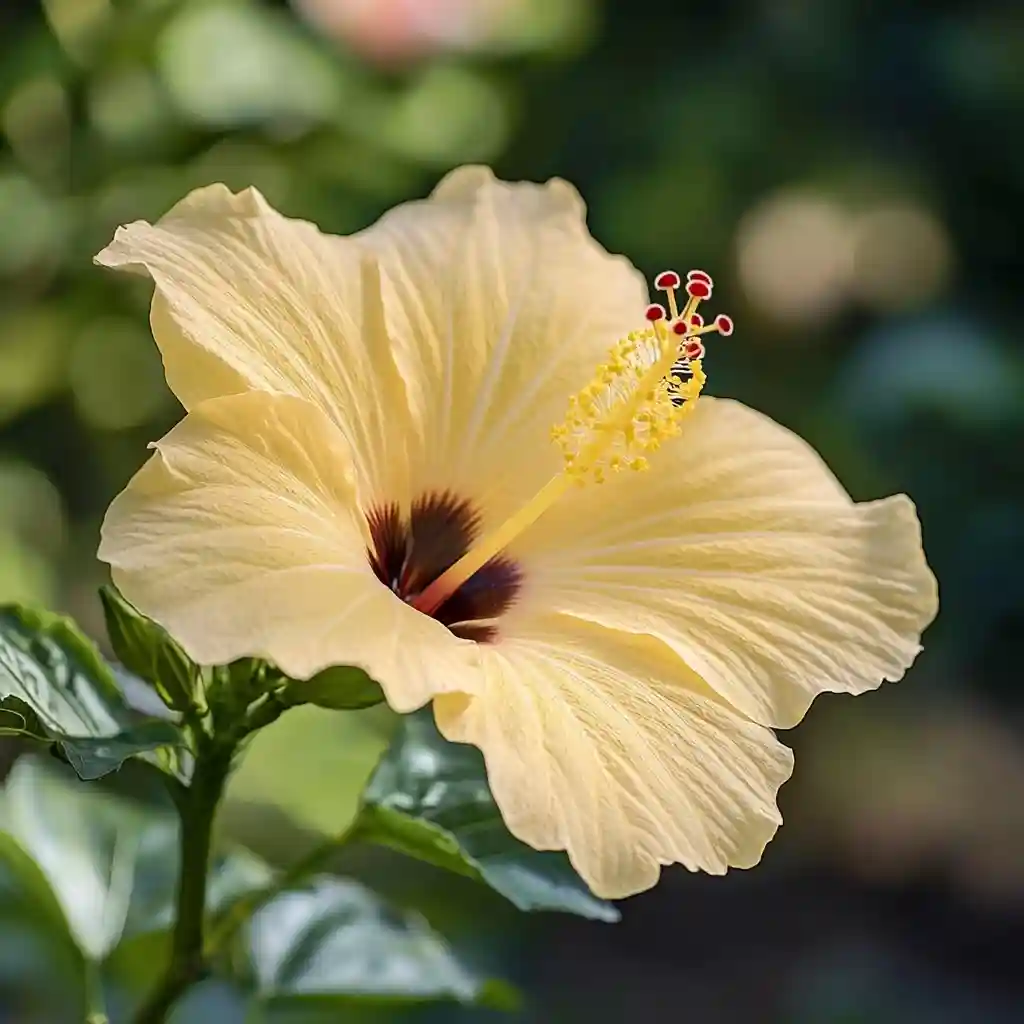
Delicate and ephemeral, Flower of an Hour (Hibiscus trionum) earns its place among the most stunning types of hibiscus for its subtle elegance and unique blooming behavior. Each pale yellow flower with a dark purple-black center opens for just a few hours in the midday sun, creating fleeting moments of beauty that feel almost magical.
This compact, bushy annual typically grows 1 to 2 feet tall, making it ideal for small gardens, borders, or naturalized wildflower areas. Native to Africa and parts of Europe and Asia, Flower of an Hour is adaptable and thrives in well-drained soil with full sun exposure. It self-seeds easily, allowing it to return year after year in the right environment.
Though short-lived, the blooms attract pollinators like bees and hoverflies, supporting biodiversity in your garden. Its delicate nature contrasts beautifully with bolder hibiscus varieties, offering a softer aesthetic in mixed plantings.
Key care tips:
- Sunlight: Full sun (essential for blooms to open)
- Soil: Well-drained, sandy or loamy soil
- Zones: USDA 8–11 (or grown as an annual)
- Water: Low to moderate
⏳ Interplant Flower of an Hour with longer-blooming hibiscus for layered color and continuous garden interest.
23. Aphrodite
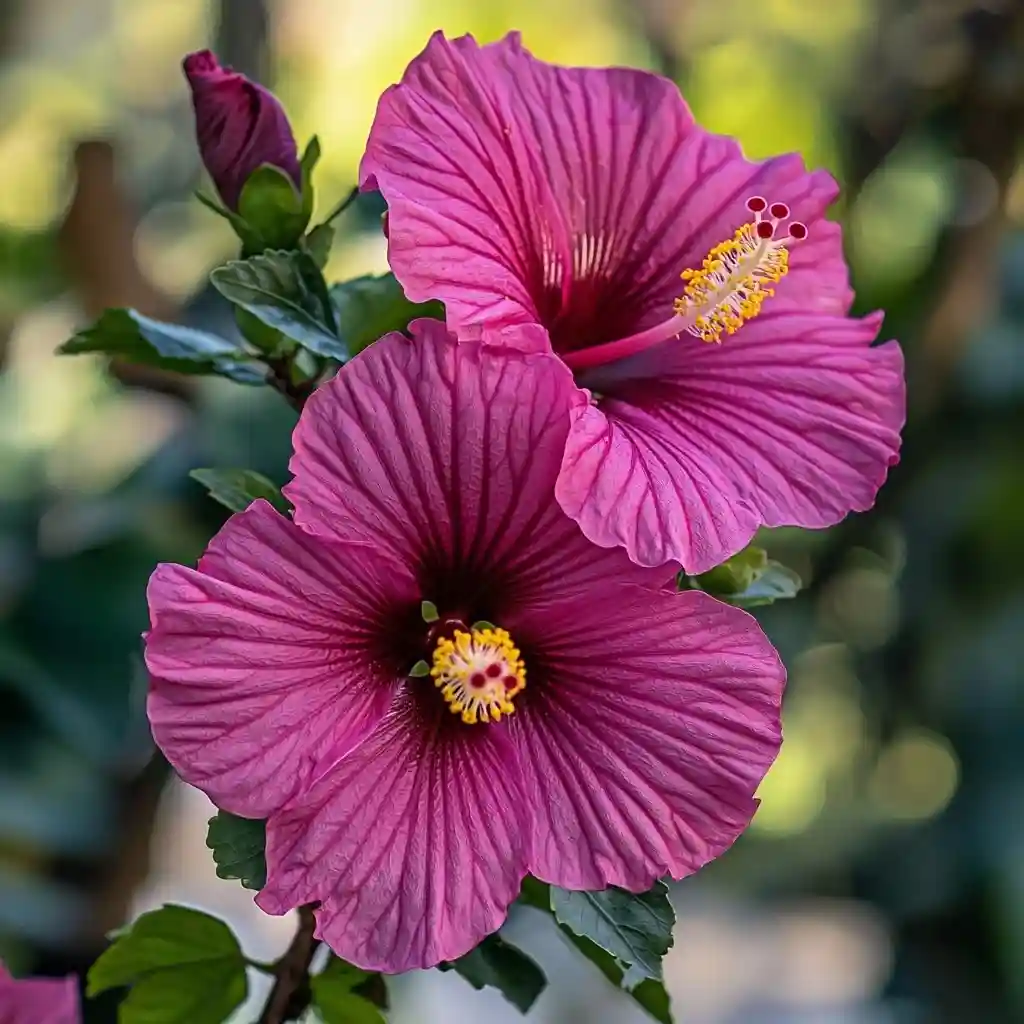
Named after the Greek goddess of beauty, Aphrodite is truly one of the most stunning types of hibiscus, admired for its large, romantic pink blooms and graceful structure. Each flower opens with soft, satiny petals in deep rose-pink, highlighted by a golden yellow throat and dark red eye that adds striking contrast. It’s a classic variety that embodies elegance and charm.
Aphrodite is a cultivar of Hibiscus syriacus, making it more cold-tolerant than tropical types. This deciduous shrub typically grows 6 to 8 feet tall and 4 to 6 feet wide, forming a dense, upright habit ideal for hedging, screening, or anchoring perennial borders. It blooms reliably from midsummer through early fall, offering continuous color when many plants are past their peak.
Low-maintenance and tolerant of urban conditions, Aphrodite is also deer-resistant and drought-tolerant once established—making it a practical choice for a wide range of landscapes.
Grow Aphrodite with ease:
- Sunlight: Full sun to partial shade
- Soil: Well-drained, moderately fertile
- Zones: USDA 5–9
- Water: Average watering needs
💕 Use Aphrodite as a romantic centerpiece in cottage gardens or pair it with lavender and coneflowers for a graceful, pollinator-friendly display.
24. Rose Mallow
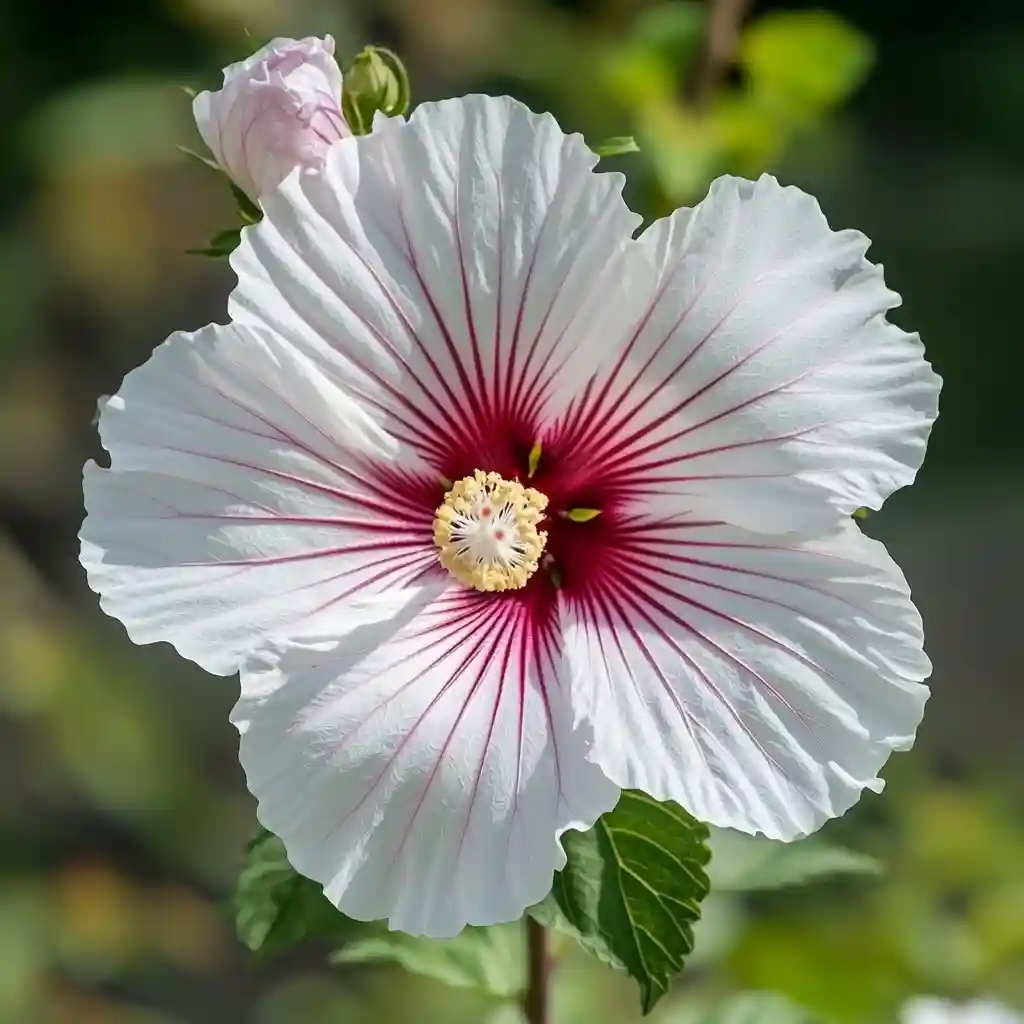
Rose Mallow (Hibiscus moscheutos), often considered the heart of hardy hibiscus varieties, is without a doubt one of the most stunning types of hibiscus for large, dramatic blooms and dependable performance. Its enormous flowers—sometimes up to 12 inches across—unfurl in shades of white, pink, red, or bicolor, often with a striking maroon or burgundy center.
This herbaceous perennial dies back in winter but returns stronger each spring, forming a robust shrub that can grow 3 to 8 feet tall and equally wide. Its deep green, heart-shaped leaves provide an excellent contrast to the bold flowers, which bloom from midsummer to early fall. Each flower lasts only a day, but the sheer number of buds ensures a constant floral show.
Rose Mallow loves moisture and performs best in sunny borders, along pond edges, or in rain gardens. It also attracts hummingbirds, butterflies, and admiring glances from anyone who passes by.
To keep your Rose Mallow thriving:
- Sunlight: Full sun
- Soil: Moist, fertile, and well-drained
- Zones: USDA 4–9
- Water: Consistent moisture is key
🌸 Group Rose Mallow with other moisture-loving perennials like Joe-Pye weed and swamp milkweed for a pollinator-packed, summer-flowering border.
25. Exuberance
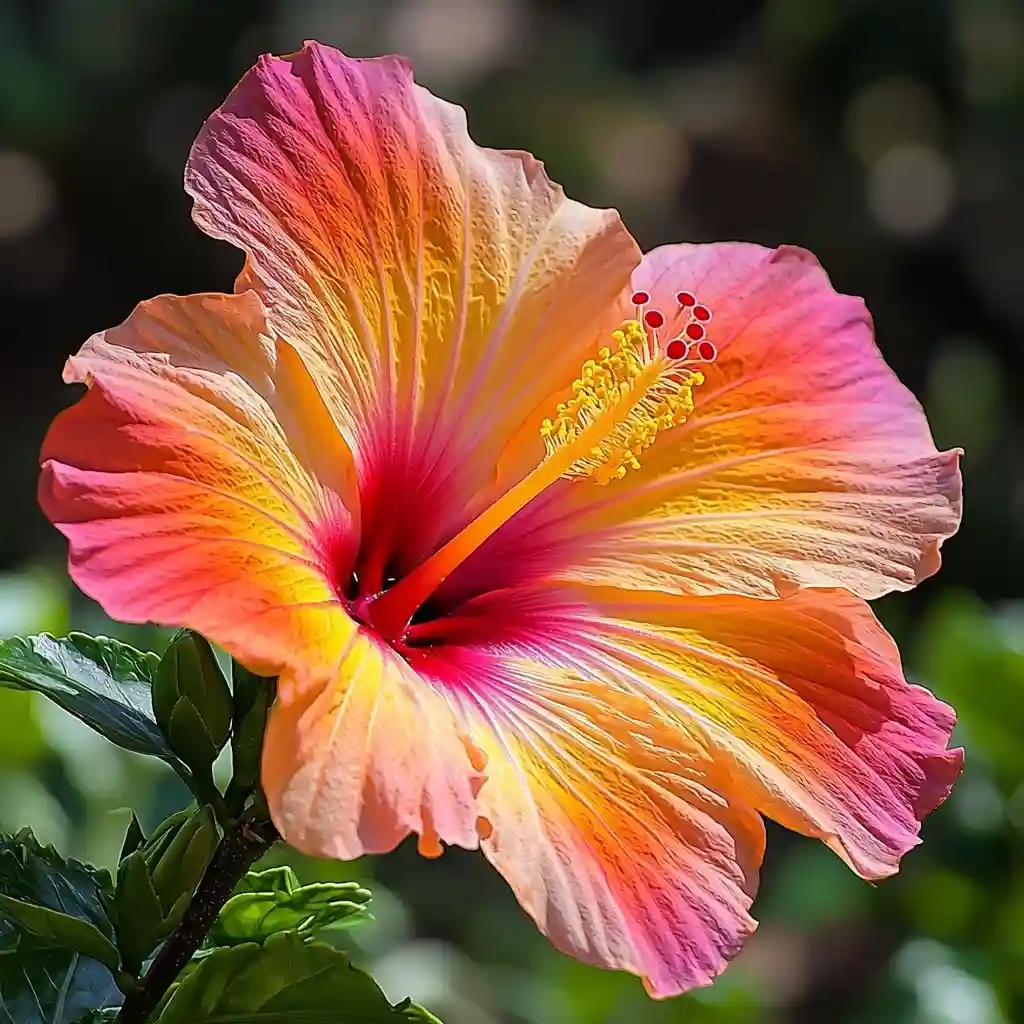
Exuberance lives up to its energetic name and stands tall among the most stunning types of hibiscus. This modern hybrid bursts with massive, multi-toned flowers blending fiery orange, golden yellow, bright red, and blush pink—all in a single bloom. With petals that appear hand-painted in watercolor-like strokes, Exuberance offers unmatched visual impact from mid-summer through early fall.
Its large, ruffled flowers span 7 to 9 inches and open wide against lush green foliage, making it a standout in any tropical or subtropical garden. The plant itself grows to a modest 4 to 6 feet tall, forming a dense, rounded shrub that fits beautifully into landscape beds, containers, or mixed borders.
While it demands warm temperatures and consistent sun exposure to look its best, the payoff is a plant that delivers nonstop color and tropical charm. Exuberance also attracts hummingbirds and butterflies, making it both a visual and ecological asset.
Growing Exuberance successfully:
- Sunlight: Full sun required for peak color
- Soil: Rich, well-drained soil
- Zones: USDA 9–11
- Water: Keep soil evenly moist; mulch to retain hydration
🎨 Use Exuberance as a centerpiece in a tropical bed with bold companions like canna lilies or elephant ears for a festival of color.
26. Blue River II
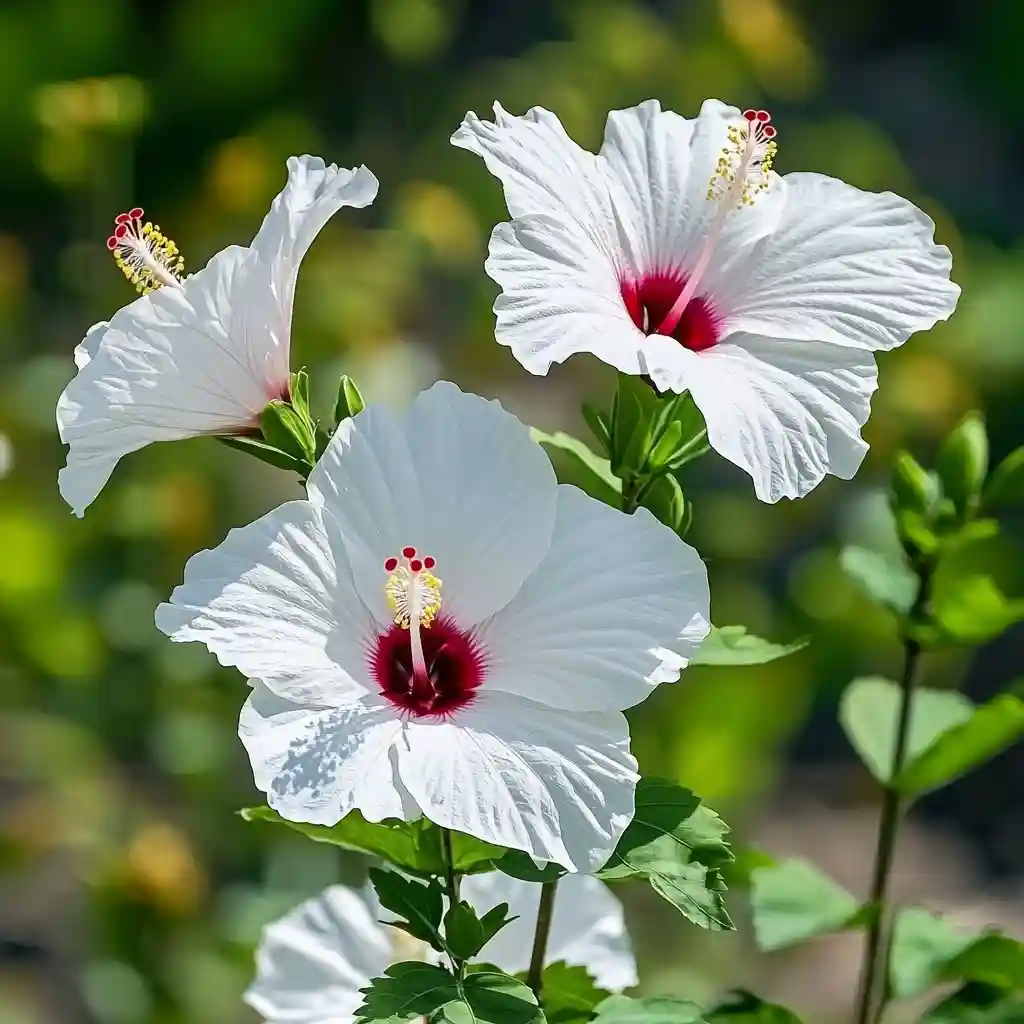
Blue River II is a striking choice among the most stunning types of hibiscus, known for its pristine white blooms that glow with elegance in the garden. Each flower, reaching 8 to 10 inches across, features pure white petals surrounding a deep red to burgundy throat—creating a luminous contrast that stands out against the plant’s deep green, heart-shaped foliage.
A cultivar of Hibiscus moscheutos, Blue River II is a hardy perennial that returns each year with vigor. It grows 4 to 5 feet tall and wide, forming a full, upright shrub that thrives in sunny, moist locations. The blooms appear from midsummer to early fall, offering a cooling color palette that complements both formal and naturalistic gardens.
In addition to its beauty, Blue River II attracts hummingbirds and pollinators, making it a practical choice for eco-conscious landscapes. It also tolerates wet soil conditions, making it a favorite for rain gardens and borders near water features.
How to care for Blue River II:
- Sunlight: Full sun
- Soil: Moist, rich, and well-drained
- Zones: USDA 4–9
- Water: Requires consistent watering, especially in dry spells
🤍 Plant Blue River II in moonlight gardens or alongside bold-colored varieties like Lord Baltimore for a striking contrast of light and dark.
27. Checkered Hibiscus
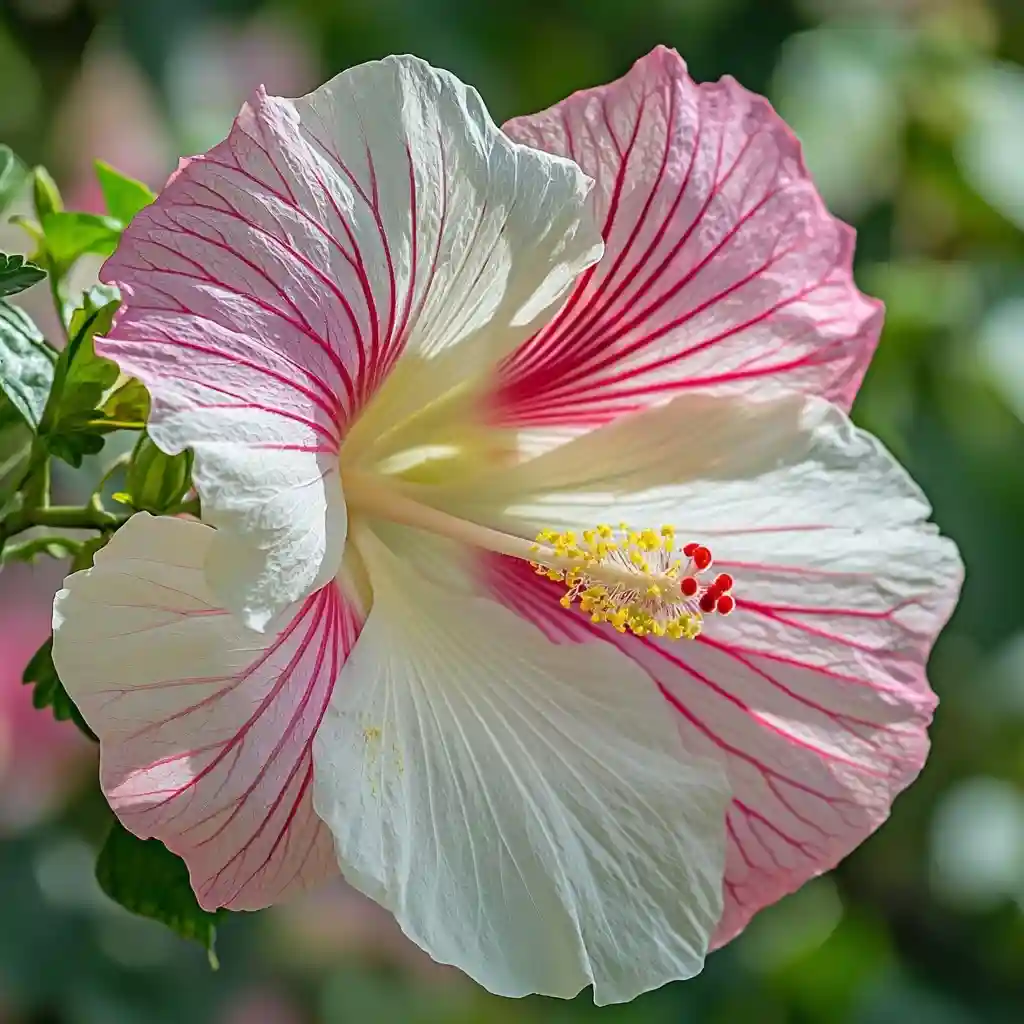
Checkered Hibiscus (Hibiscus striatus), sometimes called the “striped hibiscus,” earns its place among the most stunning types of hibiscus with its uniquely patterned petals. Each flower displays alternating bands or streaks of pink, red, white, or cream—almost as if nature took a paintbrush and decorated them by hand.
These eye-catching blooms typically measure 4 to 5 inches across and are carried on a medium-sized shrub that grows 4 to 6 feet tall. Native to wetland regions of North and South America, Checkered Hibiscus thrives in warm, humid climates and performs best in moist soils with full sun exposure.
Though not as common as other varieties, this species is highly prized by collectors and gardeners seeking unusual floral traits. Its nectar-rich flowers also draw in hummingbirds, bees, and butterflies—making it an ornamental and ecological win.
Tips for growing Checkered Hibiscus:
- Sunlight: Full sun
- Soil: Moist, well-draining; prefers rich organic matter
- Zones: USDA 8–11
- Water: Consistent moisture is key
🌀 Pair Checkered Hibiscus with solid-colored companions like Luna Red or Cherry Cheesecake to highlight its unique striping pattern.
28. Giant Rose Mallow
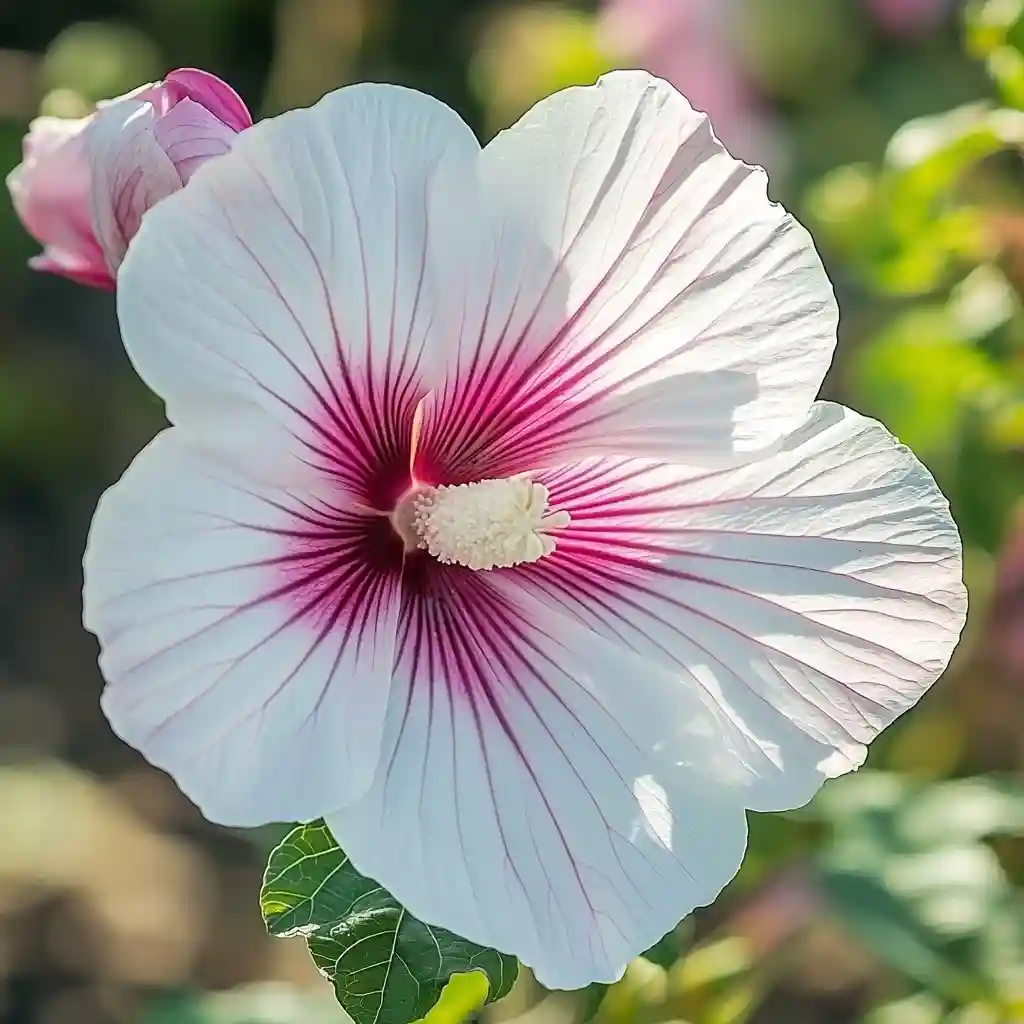
If you’re looking for a true garden showstopper, Giant Rose Mallow ranks among the most stunning types of hibiscus thanks to its massive, plate-sized blooms and bold foliage. Each flower can span up to 10 inches across, featuring soft pink to white petals with a rich crimson center. The effect is nothing short of spectacular, especially when several blooms open at once on a single plant.
Giant Rose Mallow belongs to the Hibiscus moscheutos species and thrives in wet, sunny areas like pond edges, rain gardens, or moist borders. Its robust stems can reach 4 to 6 feet tall, and the deep green to purple-tinged leaves provide dramatic contrast against the delicate petals.
A favorite among pollinators, this variety attracts bees, butterflies, and hummingbirds with its generous nectar supply. It’s also a reliable perennial in cooler climates, returning stronger each year after winter dormancy.
How to grow Giant Rose Mallow:
- Sunlight: Full sun is essential for vigorous flowering
- Soil: Moist to wet, organically rich soil
- Zones: USDA 4–9
- Water: Requires consistent watering, especially during dry spells
🌺 Plant Giant Rose Mallow as a back-border anchor or near water features for a dramatic, cottage-style look that buzzes with pollinator life.
29. Luna Pink Swirl
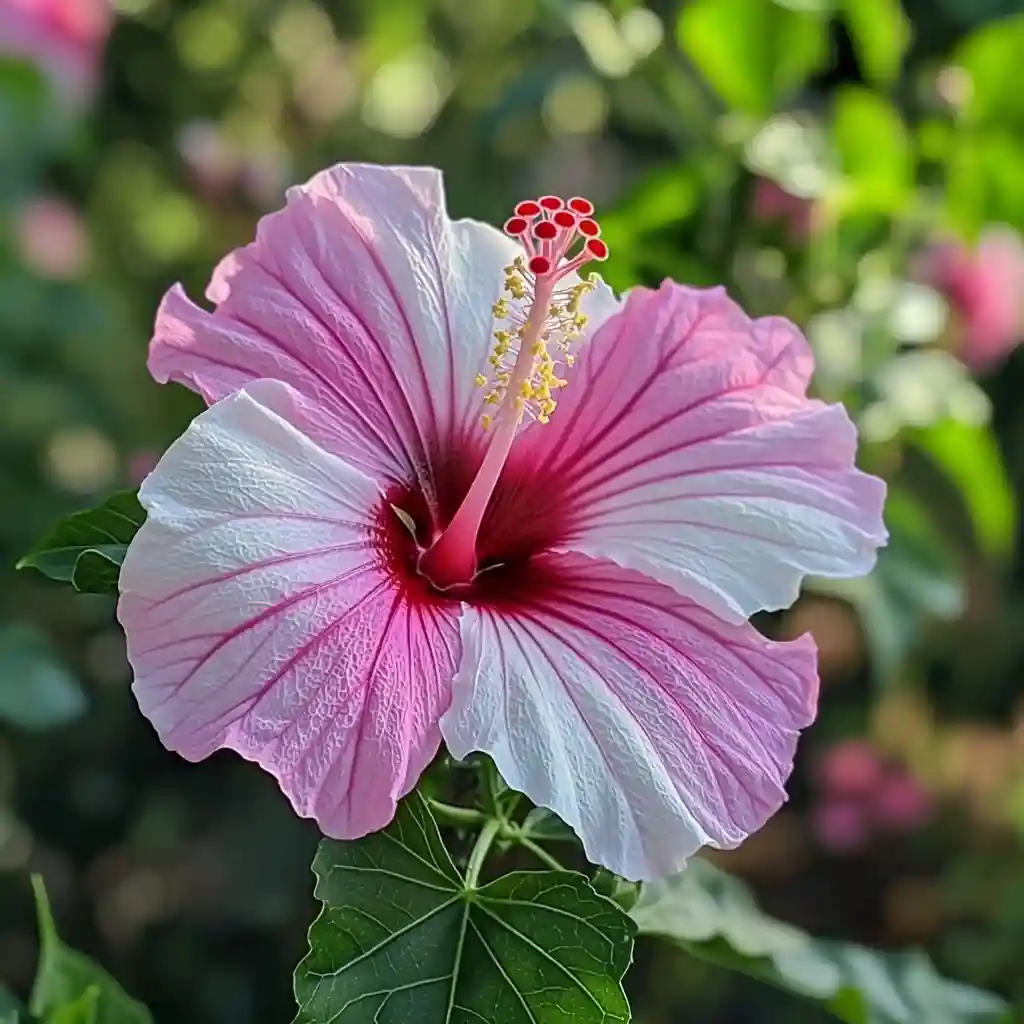
Luna Pink Swirl brings the list to a graceful close as one of the most stunning types of hibiscus, known for its breathtaking bicolor blooms. Each flower unfurls into a soft pink and white swirl pattern, centered around a deep red eye that adds dramatic contrast. With blossoms measuring 6 to 8 inches wide, it’s an ideal choice for smaller spaces where color and impact are still desired.
As part of the Hibiscus moscheutos family, Luna Pink Swirl is a compact perennial variety, typically growing just 3 to 4 feet tall and wide. Its bushy, upright habit makes it a favorite for perennial borders, containers, or as a colorful accent in rain gardens. Blooming from midsummer through early fall, this variety offers a steady display of large, nectar-rich flowers that attract butterflies and hummingbirds.
Because it’s both cold-hardy and heat-tolerant, Luna Pink Swirl is well-suited for a wide range of climates, bringing tropical flair to even temperate gardens.
Growing Luna Pink Swirl:
- Sunlight: Full sun for optimal bloom production
- Soil: Moist, fertile, well-drained
- Zones: USDA 5–9
- Water: Consistent moisture, especially during hot spells
💞 Pair Luna Pink Swirl with silvery foliage plants like lamb’s ear or dusty miller to make its pastel blooms stand out even more.
🌿 Conclusion
There’s no doubt that the garden world is overflowing with beauty, but few plants match the variety and visual appeal of these stunning types of hibiscus. From the fiery tones of Mango Liqueur to the pastel elegance of Luna Pink Swirl, each hibiscus offers its own unique personality—whether through color, size, leaf shape, or bloom pattern.
Whether you’re designing a lush tropical retreat, a pollinator haven, or simply want to add bold color to your landscape, hibiscus provides endless possibilities. And with hardy varieties like Rose Mallow and Lord Baltimore, even gardeners in cooler climates can enjoy these floral showstoppers.
Choose the varieties that suit your space, climate, and aesthetic goals—and your garden will reward you with months of vibrant blooms, buzzing pollinators, and endless compliments.
🌿 Love gardening inspiration? Follow me on Pinterest for bold plant ideas, tips, and seasonal color!
More Posts

